#it was the first and arguably most effective use of this symbol considering it set the standard for it's meaning
Explore tagged Tumblr posts
Text
Not to be slightly pretentious about my own art for a second but I'm up thinking about the repeated visual imagery I've developed in my wkm fanart
Specifically the twin stars as Celine and Damien post WKM, particularly in their relation to Wil. How it's about them haunting the narrative. How it's about them still being there in Dark and yet not being there at all. How it's about the ways Wil still sees them in everything. How he misses them and how he carries on with that weight, with their legacy (the same reason I often draw him with star motifs of his own. Always carrying them with him in his own little ways.)




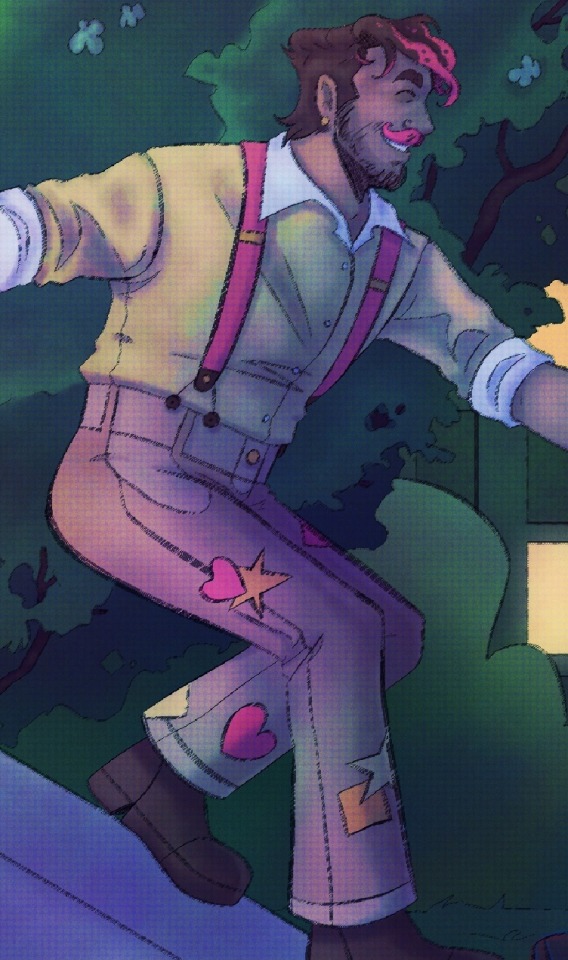
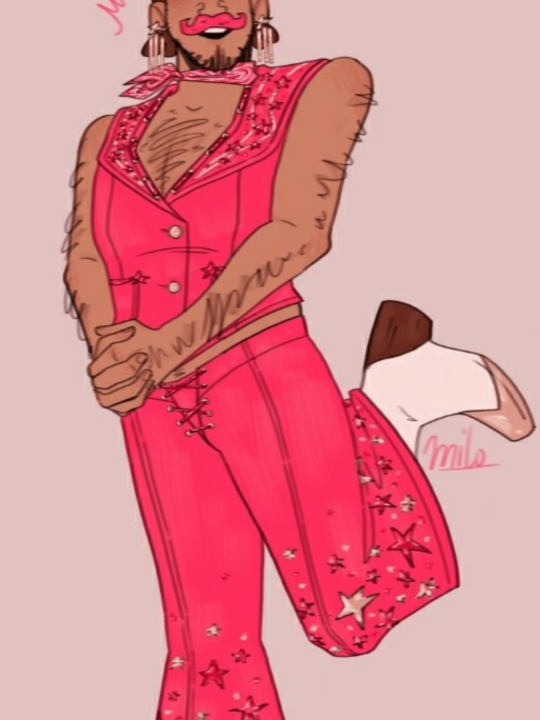

#atlas.art#atlas speaks#i wonder sometimes how many people pick up on it bc everytime i think about this shit it drives me a little insane#they are everything to me do you get it#the fucking 'Woke Up New' Wil drawing still gets me despite all the ass jokes people made about it for this specific reason#it was the first and arguably most effective use of this symbol considering it set the standard for it's meaning#also yes the stars were also a part of the reason i drew the barbie outfit drawing lmao have fun never looking at that one the same again#also not included here but slightly relevant is the google drawing with the stars#considering the specific ideas i have about google's path towards humanity and its relationship to Dark and his humanity so#anyways I'm done being pretentious now probably i swear
82 notes
·
View notes
Text
In the early hours of April 7th the Israel Defence Forces’ (idf) 98th Division withdrew from Khan Younis, the second-largest city in Gaza, exactly six months after Hamas’s attack of October 7th. Israel had the sympathy and broad support of much of the West when it sent its army to war with Hamas. Half a year later, much of Gaza lies in ruins. Over 33,000 Palestinians have been killed, according to the Gazan health ministry. The uprooted civilian population faces famine. Israel has lost the battle for global public opinion. Even its closest allies, including America, are considering whether to limit arms shipments. Much of the criticism centres on Israel’s armed forces. Even after its devastating failure to prevent the massacres of October 7th, the idf has remained the most cherished institution in Israeli society. Holding fast to the vision of the idf as both effective and moral is essential to Israelis’ image of themselves. But it is now accused of two catastrophic failures. First, that it has not achieved its military objectives in Gaza. Second, that it has acted immorally and broken the laws of war. The implications for both the idf and Israel are profound.
Major-General Noam Tibon is a retired corps commander who on October 7th rushed to his son’s kibbutz near Gaza, single-handedly extricating his young family while Hamas was on the rampage. In hindsight, he says, the idf should have gone into Rafah first. He believes his former colleagues were “under the illusion that going first into Gaza City would break Hamas psychologically, by taking their symbols of government”. But, he argues, “all the talk of dismantling their brigades and battalions is rubbish. They remain a fundamentalist movement which doesn’t need commanders to fight until death.” The lack of enforcement of even these looser rules of engagement has been such that accusations that Israel has broken the laws of war are plausible. “The standing orders don’t matter in the field,” says one veteran reserve officer who has mostly been in Gaza since October. “Just about any battalion commander can decide that whoever moves in his sector is a terrorist or that buildings should be destroyed because they could have been used by Hamas.” “The only limit to the number of buildings we blew up was the time we had inside Gaza,” says one sapper in a combat-engineering battalion. “If you find a Kalashnikov or even Hamas literature in an apartment, it’s enough to incriminate the building.” Other officers reported a breakdown of discipline in their units, with multiple cases of looting. “I think everyone in our platoon took a coffee set,” said one sergeant. Soldiers have filmed themselves vandalising Palestinian property and, in some cases, put those videos online. On February 20th the idf’s chief of staff published a public letter to all soldiers warning them to use force only where necessary, “to distinguish between a terrorist and who is not, not to take anything which isn’t ours—a souvenir or weaponry—and not to film vengeance videos.” Four months into the war, this was too little, too late. “He should have acted much sooner to root this out,” says one battalion commander. The idf’s third failure is its role in Israel’s obstruction—until an angry phone call between President Joe Biden and Mr Netanyahu on April 4th—of aid efforts to Gazans. Officers have mainly blamed the politicians for this. But some acknowledge that even without a political directive, the army, which is arguably an occupying force in Gaza now, should have assumed this responsibility from the planning stage. Instead it acted only when the humanitarian situation became critical. That does not bode well for the future. The war in Gaza is not over. Israel’s next step is unclear. Mr Netanyahu says that a date has been set for an incursion into Rafah, Hamas’s last major stronghold (in private, Israeli generals deny this).
#yemen#jerusalem#tel aviv#current events#palestine#free palestine#gaza#free gaza#news on gaza#palestine news#news update#war news#war on gaza#palestinian resistance#fuck the idf
191 notes
·
View notes
Note
HELLO YES ITS ME IM COPY PASTING THE THING HERE:
YOU JUST MADE THE CHILD IN ME BLOOM. THE QUESTION LIST (THIS IS THE FIRST TIME IM SEEING THIS AU BUT GOD FORBID):
× Who's Hoodie
× Is it in the same time setting as MH
× Who PLAYS AS ALEX
× Did it start the same way as a dumb school film project?
× From what I understood Scar takes the role of Tim, is bro a chainsmoker too LMFAO.
× Is Grian canonically gay too
× Would it be a wild correct guess that Amy is Lizzie and Alex is Joel since yk based from obvious plot points?
(before I start, placing this disclaimer here at the top since I have friends who don't frequent mcyt and might get confused, but when I talk abt this au I'm specifically talking abt the characters, not the content creators themselves. Anyway)
SO IM GONNA GO AHEAD AND SHARE WHOSE WHO FIRST
Jay- Grian, it made the most sense in my head, but I actually flip flopped on this so many times bc he also works so well as Tim or Alex, but at some point I went "wait it's an au, we can see how the story changes with Grian as the protag" so Grian's the protag now
Tim/Masky- Scar, I'm a transparent desert duo enjoyer and had a similar flip flop with him as I did Grian bc he'd also work as Jay but I was halfway through that drawing and had a similar thought process to the one i had abt Grian
Brian/Hoodie- Jimmy, I wanted to keep the cast focused to life series and evo members and he made the most sense to me lore wise, especially with the idea that in this au he was one of the ones with the earliest exposure to The Watcher (bc I love Canary Curse symbolism)
Alex- This one was the toughest choice bc no matter what a fav is going to loose it. Good thing this based on the Life Series! As much as I Love the idea of Joel and Lizzie as Alex and Amy, I actually went with Martyn. Again, the character is pretty involved with the Watcher Lore so it made the most sense as the character that is arguably most effected by it. (Although for a brief moment I considered Mumbo Jumbo bc,,, how fucking funny would that be)
Jessica- Jessica's gotta be Pearl right? It makes the most sense for it to be Pearl, I don't even need reasoning for this it makes sense
Amy- So who's Amy then? Scott actually! He's not Martyn's boyfriend in this, he's just a really good friend of his who was super involved in the production. Also like in mh, he's Pearl's roommate.
Sarah- Ren. Can't have a life series au featuring desert duo and not have some renchanting. Who else would be one of the leading actors in Martyn's short film?
Seth- Big B, again Evo connection made sense to me, and depending on your own personal theory on who the third person running the totheark account is, both Big B and Ren have interesting implications, even if both their rolls are p minor in this au
With the cast out of the way other questions !!!
It's set in a kind of nebulous time frame that's probably a little closer to present day, but it does still start with a student film project. When asked Why Martyn chose to use tapes he says something about wanting a more authentic feel to the film but in reality he just thought using tapes was a cool idea and doesn't want to admit that it's kind of impractical now.
In this au Scar doesn't smoke, but instead I like the headcannon that he just has boxes of candy/bubblegum cigarettes on him at all times. He'll pull one out, pause, and offer one to someone and when they say no he's just like "Okay, your loss" and watch as they get all confused when he starts unwrapping it asdfghkgkdjhfjsh
Is Grian gay in this au? Whose to say. (Real answer tho, I'm a notorious Jam shipper and while I'm not an active shipper when it comes to hermitcraft or the life series, I don't really mind it so the relationship is left kind of ambiguous)
But yes THANK YOU DO MUCH FOR GIVING ME A CHANCE TO TALK ABT THIS IVE BEEN RAMBLING TO MY FRIEND WHO DOESNT UNDERSTAND ANYTHING IVE BEEN SAYING FOR DAYS
39 notes
·
View notes
Text
04_journal
Marshall McLuhan’s theory of hot and cold media explores how a medium may support or require user participation and how effectively information or data are defined for a viewer. To analyze a medium, one can simply question whether it is interactive, needing user interpretation like a conversation, which is considered cold, or if it is content-rich, like a lecture considered hot. For my encoding project, I am creating a visual essay analyzing themes of betrayal in painting, film, and television to determine what common motifs and symbolisms are shared and why. Using McLuhan’s media theory, I can further examine these mediums.
My first medium, painting, is hot. Now, the painting is not directly mentioned by McLuhan. However, photography a similar medium is. A photograph is a fact. Even if a scene is manipulated or presents an inauthentic story, the image represents that the moment existed and is, therefore, valid. McLuhan has defined photography as hot, because of its high-definition data, which is only presented visually, in the similar manner that radio is only presented audibly. Since a photo takes the role of communicator, viewer participation is denied, forcing them to consume whatever information is presented. These same ideas can be applied to paintings since they also define the shared content and limit user interaction.
My second medium, film, is hot as well. McLuhan suggests this because of the planning, structure, and execution when producing a film. Films are intentionally crafted through script writing and set design to acting and cinematic techniques. This preparation aims to present a clear, high-definition message to their viewers within a given time. Like painting, film is a medium requiring little to no participation; the role of the audience is to absorb and interpret the data provided to them. As an audio-visual medium, the film can adopt strategies used in radio and photography to enhance messages further. Arguably, film could be the hottest medium, considering McLuhan’s approach.
Lastly, my third medium, television, is considered cold. While television is another audiovisual medium, it differs from film because it has a lower definition in both image quality and data. Television calls on the attention and participation of its viewers to engage with the content. For example, news and advertising serve the possible needs of parents and cartoons serve the children that may watch. The film can exist in itself, but television finds purpose through its audience. Another aspect of television is that users control what content is being shown, which affects how information is interpreted. Consider that a person is flipping between an educational program and cartoons. Regardless of how data-rich the program is, users cannot gain information because the message is constantly changing.
While exploring McLuhan's theory, it is vital to understand that hot and cold media is not definite and can be redefined based on individual experiences. For example, McLuhan stated that Film is hot, but what if a user is blind? Would braille become their hot medium since it is content rich like print and the alphabet? Braille also requires user participation; would this make it cold? Learning about the audiences that media engage with can help better understand the most relevant mediums for them to interpret messages.
0 notes
Text
Gingerbread man as golem
@yaronata asked:
I would like to write a character who is Jewish and uses a Golem. She's based on the D&D class of the artificer which looks magic but isn't, because they produce all their effects with inventions, like the "any sufficiently advanced technology is indistinguishable from magic" quote. Her story is that her very Jewish town was under attack from a terrible monster when she was little. Her Rabbis made a Golem to protect the town, and it succeeded but was torn to pieces in the process. She was fascinated by the Golem and as a kid didn't see a big difference between it's sentience and person's so was really thankful for its sacrifice like you would a person's sacrificing their life for you. They thought all the pieces had been devoured by the monster before it died, but she went looking and found the piece used to animate the Golem, which she, kinda misunderstanding called its "heart". She kept the piece and grew up to be an incredibly skilled cook, specialising as a baker in the town. I imagine she would make a lot of really good food for the Jewish holidays, or to break fasts on ones like Yom Kippur or Tish'abav. But she also made a town specific holiday to honour the Golem's sacrifice and the town still being alive, because I feel "we are not dead woo" is a big theme for Jewish holidays from my research, so it could fit, for which she invented ginger bread men to be the golem, and gave them little "hearts" of fruit or honey, and you're meant to eat them limb by limb like the beast did before eating the heart. This would be the inspiration for using the "heart" piece later to make her own giant gingerbread Golem to help her save the world.
These are my questions 1) would it be considered bad or disrespectful for someone who isn't a Rabbi to make a Golem, or is this method of taking an animating piece someone else made disrespectful? 2) Her journey will take her far from her town and her Jewish family and friends and she will likely travel with gentiles. Would it be disrespectful for a Golem to be used to protect a lot of gentiles and one Jew in the course of saving the world? I don't want to fall into the stereotype of someone putting all their effort into valuing and protecting very specifically the group that in real life is oppressive to them. 3) While she is not using magic and is actually mimicking its effects with technology she invents, is this drawing too close to the line of "magical Jew"? 4) I like to "play test" my characters in ttrpgs to really get a feel for them before I write. Would it be disrespectful to play a Jewish character when I am a gentile, and would it be disrespectful to play a Jewish character in a setting where there are demonstrably real gods other than the one of Judaism?
I really like this character idea and I think it's cute and fun and rooted in Jewish culture but I really want to make sure it's respectful and as good as I, a gentile researching on the internet, thinks it is. Thanks so much! Have a nice day!
My answer to this is very complicated because there are things I both like and do not like about this premise. First of all, I love the idea of a cookie golem, and I'm even imagining the magic word that brings him to life (EMET/truth) would be written in icing. And I'm okay with the part about how she found a piece of the old golem and used it to build a new golem, because that makes sense for a golem made from a baked good when you think about how people use sourdough starter to make a new batch of sourdough.
However, here are the thing that make me cock my head to the side like my little sister's German shepherd:
1. re: "magical Jew" - that's not a trope I've ever heard of. Remember, marginalized groups don't receive identical disrespect across the board. It is indeed a trope to use Black people or disabled people as supernatural plot devices who exist only to further the stories of white main characters or able-bodied main characters. But I can't say as I've ever seen anyone using Jewishness that way. Usually if we are someone's one-dimensional plot device it's as someone's lawyer, fixer, "money guy", etc, not a supernatural force. So this isn't something you have to worry about.
2. I have a certain level of discomfort with you playing as a Jewish character just because playacting as a marginalized culture you're not part of strikes me as off, but I understand that that's how you gain insight into a character you're about to write so it's more of a writing exercise than anything else. (I wonder if D&D regulars from marginalized groups have written about this -- I've only played a few times casually with family so if I did run into this type of discussion in my social justice reading I wouldn't have absorbed it. If anyone is curious I played first as Captain Werewolf, and then switched to playing as Cinnamon Blade because lawful good was too hard. :P )
3. I would prefer you omit the detail about eating the cookies piece by piece symbolically, for two reasons: a. it unintentionally evokes Communion by having appreciative people consume a baked good symbolic of an entity who sacrificed his life for theirs, and b. focusing on the details of flesh consumption reminds me too much of Blood Libel (yes, a gingerbread man is in the shape of a person but how many of us actually think about it literally, the way this act would cause?)
As to your first question: I'm fine with her making a golem even though she's just a rando. Second question: I see what you're saying and maybe it could be more okay if it's really clear how well these gentile folks are treating her? And questions three and four are answered above.
I really do love the idea of a giant gingerbread man golem. Cookie golem T_T <3
--Shira
I would like to second Shira’s point about not ripping apart the gingerbread cookies. I honestly would prefer they were used as decoration, and other cookies eaten instead, since that part just feels so not-Jewish to me, but I don’t have golem-specific issues other than that. It seems like you have already been doing a lot of research, which is appreciated.
As far as the ttrpg/DnD aspect… I bounce back and forth on the topic of playing characters that are so very different from our experiences, other than in fantasy-related ways. However, I am aware that a lot of people will play with, and experiment with gender in game, and learn something about themselves in the process (the number of trans players of ttrpgs who tried out their gender in game before they were out is high). It’s different with Judaism, and even more significantly different when it comes to things you can’t convert into, like various actual, real-world races. But because people do sometimes experience growth from experiences like this, I’m hesitant to dissuade players completely. I do urge you to, at a minimum, bring the same care, research, and willingness to learn, that you brought to this question.
--Dierdra
This sounds like a creative storyline that you could have lots of fun with 😊
At first I was confused by this part:
She also made a town specific holiday to honour the Golem's sacrifice
But then you really got me thinking about different types of Jewish holidays and how they come about, so thank you for that!
Because it’s often the little details that either make a story super powerful or kind of nonsensical, I think it would be a good idea to decide what type of holiday is being created here:
A full-blown chag with restrictions on labour and halachic obligations? These are commanded in Torah and new ones can’t be added.
A minor yom tov with halachic obligations but no restrictions? These were instituted by the rabbis prior to the destruction of the Temple, so again new ones can’t be added.
A public holiday or equivalent? This would usually be declared by the Knesset in Israel, and filter to the rest of the Jewish world from there.
A community-based yom tov with specific customs only for people in the know, such as certain Chasidic groups celebrating the birthdays of their deceased leaders? I asked around, but no one can really tell me how these holidays get started, which is probably a good indication that they arise quite organically from a group of people who all just feel that it should be celebrated. Probably not created by a single person, as such.
Something she runs from her bakery, not religion-based, but more like a day of doing special products and deals the way many small businesses do on their anniversary?
Now, if the people of a modern-day town were actually saved by a real live Golem, that would arguably be the most overt miracle for many generations, so there would be a decent chance of options 3 and/or 4 happening. It’s entirely plausible that there could be special foods for this day that become a tradition, including Golem cookies. People who directly benefited might also return to the site where the Golem fought the monster and recite the prayer, ‘Blessed is Hashem, Master of the Universe, Who performed a miracle for me in this place.’
Alternatively, if it’s important that your MC created the holiday, something like option 5 might be the best. Hopefully this will still fulfil what you need: you describe her as incredibly skilled, so I can imagine the day when she goes all out on the Golem cookies being one of the most exciting events of the year for the townspeople, just because her baking is that good. Plus, they already have a personal stake in the Golem’s sacrifice, so I definitely think it could be a thing without being an official holiday. Also, if she is outside of an all-Jewish environment, don’t forget that she would have to decide whether to commemorate the anniversary in the Hebrew calendar or the local one.
Coming back to the cookies, sorry if we’re getting a little repetitive on this point! But I don’t see the cookies being torn limb from limb as part of a celebration. First of all, this doesn’t sound like a very celebratory thing to do, to say the least. Can you imagine explaining that to a three-year-old on their first Yom HaGolem? They would be terrified! (I don’t read this suggestion as accidental anti-Semitism so much as getting carried away with a metaphor, which I’m sure as writers we have all done!)
But also, it’s worth pointing out that our commemorative foods aren’t usually that literal. If you think about hamantaschen, maror, or apple in honey, they’re all symbols. That’s not to say that having Golem-shaped cookies is a problem, as this sounds like just a bit of fun that the MC is having and not something that is directly at odds with Judaism or Jewish culture. But it’s worth bearing in mind that the more literal you go from there in terms of tying the cookies to the event they commemorate, the less culturally aligned your holiday food becomes.
Finally, about the Golem protecting non-Jewish people: I like this idea! There’s a stereotype that we only use whatever is at our disposal to help ourselves and other Jewish people, so a Golem being created by Jews but helping others as well is a big plus for me. Of course, as has already been pointed out, this would be an odd choice if her Saving The World team were anti-Semitic or otherwise disrespectful to her/her community, but I don’t think you were headed that way!
-Shoshi
I have to come back in here just to squee over the phrase “Yom HaGolem.” Well done :D
--Shira
420 notes
·
View notes
Text
The way I see some discussions and mentions of Nie Dad’s death, they give the impression that Wen RuoHan killed him in the same manner Meng Yao killed those Nie cultivators in the Sun Palace: by savagely cutting him open and letting him bleed out across the floor while Nie MingJue could only stand there and helplessly watch.
And like, symbolically, I can see the similarities of teenage Nie MingJue having to just stand there and watch his dad rage himself to death in his sickbed, but what happened between Wen RuoHan and Nie Dad, and the Wen Sect and Nie Sect, is much more complicated and far less direct.
There are reasons Nie MingJue’s resentment is quoted as being about his father’s death and not, directly, at Wen RuoHan.
Three key points:
First, neither the Nie nor the Wen could ever possibly agree about who started the conflict or how it ended. Was Nie Dad truly the arrogant type who would be so prideful as to mock Wen RuoHan for enjoying something or did Wen RuoHan try to teach a lesson to someone who was the innocent victim of some guest cultivator’s malice? The guest cultivator played them both by setting up a lose-lose situation.
Second, Wen RuoHan did not and does not know about the saber spirit. Nie Dad was stuck in a sickbed for six months which shows there was plenty of time to heal him. Do the Qinghe Nie just not take care of their people? The Wen Sect love getting into other people’s business and they have fantastic doctors. Did the Nie Sect reject help when it was offered due to the secrecy of Nie Dad’s underlying condition? This Sounds Like a You Problem if the Nie Sect just let Nie Dad languish and die. It’s no wonder Nie MingJue would resent his father’s death if there was nothing in-house they could do to help him and the Nie Sect refused to seek outside help--especially for reasons of Sect pride.
Third, Nie Dad’s death, namely how Nie Dad handled being injured and the six months leading up to his death, was a horrific reality check for the Nie Sect and the consequences of their saber cultivation. Wen RuoHan did not lay hands on Nie Dad or attack him in any manner, and yet one indirect hit shattered what tenuous hold Nie Dad had on his temperament. How fragile and vulnerable the Qinghe Nie must have felt! Wen RuoHan found their fatal flaw by a complete accident! It’s easier for the Nie Sect to blame the Wen Sect when there is nothing they can do about changing their cultivation methods without completely changing the Nie Sect as they know it. Change is hard. Blame is easy. Anger is easy. Resentment is easy.
Keep in mind this conflict was not started by Wen RuoHan. I cannot emphasize that point enough. This conflict began when a guest cultivator heard the innocuous question, “What do you think of this saber of mine?” (ch. 49, ERS) and started naming names.
Wen RuoHan smacked Nie Dad's saber because he was told Nie Dad was arrogant, boastful, and condescending. He was told Nie Dad was a dirty liar who would compliment Wen RuoHan’s saber to his face and talk shit about it behind his back (or in his heart, which is kind of worse, actually).
[The guest cultivator,] "[Sect Leader Nie is] awfully arrogant, always boasting about how his prized saber is absolutely unrivaled, and how even in a hundred years no sword has been able [to be] compared to his. No matter how good one's saber was, he definitely won't admit it, and even if he did admit it out loud, he won't admit it in his heart." [Ch. 49, ERS]
Is this a true account of Nie Dad’s character or is it a complete fabrication in order to throw him under the bus? We’re never told. But Wen RuoHan is told that Nie Dad will not be telling him the truth about how he feels, so Wen RuoHan can’t even talk to Nie Dad about it in order to clear the air if he so wanted. The guest cultivator has put Wen RuoHan and Nie Dad in a lose-lose situation. The conflict has immediately degraded to petty passive aggressive revenge.
Wen RuoHan decides to test the waters. Or, perhaps, he will teach Nie Dad a lesson in humility.
[Wen RuoHan,] "Are you sure about that? Well, I want to see." (Ch. 49, ERS)
Wen RuoHan requests Nie Dad’s presence. He holds the saber and compliments that it’s a very good saber. Then he does one of three things: he tests the saber’s strength for himself, teaches Nie Dad a lesson about having too much pride, or both.
Wen RuoHan smacking the saber, trying to break it, is a good way to humble a man whose pride comes from having the so-called greatest saber. Maybe when that saber breaks Nie Dad won't be such an arrogant asshole anymore. The guest cultivator noted that the saber was a point of pride for Nie Dad. Take it away, and maybe he’ll be more humble from now on.
The saber should probably have broken when slapped several times, but it didn't, because it was indeed a good saber.
Wen RuoHan hands the saber back and that is the end of Wen RuoHan’s involvement with Nie Dad and the Nie Sect.
(Keep in mind that we hear about Wen RuoHan leaving his house ONE time in canon, and that was to fight Nie MingJue at Yangquan during the Sunshot Campaign. Wen RuoHan and the Wen never go after the Qinghe Nie again until after the Sunshot Campaign begins.)
Nie Dad leaves the Sun Palace without noticing anything wrong with his saber. He finds the encounter with Wen RuoHan strange, but he leaves it at that.
The Sect Leader of the greatest saber cultivation sect didn't know his own saber had somehow been damaged! How embarrassing for him when he went on a night hunt days later and it broke and he got severely injured!
And that's it. Now Nie Dad's saber isn't the greatest saber anymore. Wen RuoHan taught Nie Dad a lesson, purposefully or not, and Nie Dad is still very much alive. Cultivators aren't down with their injuries for very long. It took Qingheng-jun a month to die from his critical injuries. By comparison, the core-less Jiang Cheng recovered from his broken ribs in just 3 days and the core-less Wei WuXian healed from an abdomen wound in a week. Six months for Nie Dad, a capable cultivator with likely a powerful golden core, is a long time! Unlike Qingheng-jun, he arguably was at least in a stable if disabled condition if he lasted six months.
Lesson learned and he'll be fine.
But Nie Dad isn't fine. He stews in his anger, his embarrassment, his resentment. He lets his fury engulf him. He can't heal from his injuries because all he wants to do, let’s say, is rage and yell and fume about that fucking Wen RuoHan who played a dirty trick!
(And if he did rage as such, perhaps there is some hearty arrogance in him that he thought himself and his saber untouchable, that he didn’t even give it a second look after Wen RuoHan was involved.)
It's not clearly stated if Nie Dad died from his injuries or by qi deviation, but considering the extent Nie MingJue and his sworn brothers go to in order to avoid a qi deviation AND Nie MingJue’s own feelings with how his father died, it's highly probable that Nie Dad died from qi deviation. And, like I said, if a cultivator doesn't die immediately from their wound, and if the wound doesn’t even put them in a critical condition, they heal just nicely.
But Nie Dad dies. It’s interesting to note the description of Nie MingJue’s trauma:
The thing in Nie MingJue's life that he loathed and regretted the most was the death of his father...
After Sect Leader Nie was brought back [from the night hunt where his saber broke], he couldn't make peace with such an event no matter what, and his injuries didn't heal either. Having fallen ill for half a year, he finally left the world, from either the anger or the illness. The reason why Nie MingJue, along with the entire Qinghe Nie Sect, detested the Qishan Wen Sect with such intensity was due to this. (ch. 49, ERS)
Although the Wens become the target of Nie hatred in the wake of Nie Dad’s death, Nie MingJue isn’t loathing them specifically. It’s not Wen RuoHan he hates, but rather the death of his father. The nuance here is important. He loathes those six months where Nie Dad could not get better and refused to get better when he picked his anger over healing. Those six months where he would have lashed out and shouted at his innocent children--just like Nie MingJue would, years later, shout and lash out at his brothers.
The death of Nie Dad showed the very worst side of the Qinghe Nie Sect and the effects of their saber cultivation. And all Nie MingJue, just a teenager at the time, could do was stand there and watch it all unfold. What a nightmare. It’s no wonder he accepted help from the Song of Clarity when he did, especially when Lan XiChen and Jin GuangYao were amping up the risk. it really just highlights the outrageous betrayal by Jin GuangYao, who knew all of this about Nie MingJue and the Nie Sect and still did what he did, using intimate knowledge to slowly murder Nie MingJue for his own gain.
Not even Wen RuoHan was that cruel.
Because all the while Wen RuoHan is not aware of the saber spirit or Nie Dad’s high risk of qi deviations. Nobody outside the Nie Sect knows about the saber spirits. Outside the Nie Sect, saber spirits aren't a real thing that someone could reasonably plan for. Hell, even Nie HuaiSang went over twenty years not knowing about the saber spirits and he lived with them!
So there is no possible way Wen RuoHan could have suspected pulling a punk ass, petty stunt to humble Nie Dad would exacerbate this supernatural disease that would anger Nie Dad to death.
This isn’t to say that Wen RuoHan is innocent. He very much chose to call Nie Dad over and made the decision on his own to smack the saber. But fate took over after that. The saber didn’t have to break and it didn’t have to break at such a dangerous moment.
Wen RuoHan’s actions did not seek Nie Dad’s death--because if he wanted Nie Dad dead, he would have killed him. (Who could have stopped him? No one.) Having policies that cause injury but not necessarily death are kind of Wen RuoHan’s thing though. (That’s an analysis for another time.) Suffice to say, no one can learn their lesson if they’re dead. Indoctrination camps and supervisory offices require living, breathing people to teach and be supervised. Wen RuoHan never sought to take over the world, only to correct the obvious flaws in the world around him. Correcting Nie Dad’s arrogance and pride was such an attempt.
And the Nie Sect secrecy shot the Nie in the foot in the end. They were angry with Wen RuoHan and the Wen Sect for causing Nie Dad's death by causing his injuries by damaging the saber, but of course Wen RuoHan and the Wens would never agree with this under the known circumstances. And with them being Wens, of course they aren’t going to take the blame and no one else is powerful enough to force them. This whole situation is especially Not Their Fault from their point of view.
Nie Dad was in bed for six months without critical injuries.
Maybe the Nie Sect should have had gotten better doctors.
(And I can perfectly imagine the Wen Sect, always throwing their weight around, actually offering to send their doctors, arguably the best doctors in the cultivation world, and the Nie Sect refusing because what ailed Nie Dad was not something the Nie Sect wanted to share. Nie MingJue allowing his sworn brothers to help him shows he learned from the experience of his father’s death, but I digress.)
We know all of this to be true because Wen RuoHan, years later at the start of the Sunshot Campaign, speaks of the Nie Sect as a place where people die in part because of their personality type and in part because the Nie Sect itself fails to care for them:
...the Qinghe Nie Sect's sect leader [Nie MingJue] was so stiff that he'd easily snap in half--soon afterward, no need for others to move and he'd die in his own people's hands sooner or later... (ch. 61, ERS)
And considering what we know about the saber spirits, this is a pretty good deduction when Wen RuoHan is missing the saber spirit cornerstone. The Nie Sect has a cultivation tradition that kills them. Obviously it’s in the hands of their own people that they die, having picked up this cultivation style. Wen RuoHan also accurately determines that personality, such as Nie MingJue being inflexible, contributes to that death. It is the build-up of anger and resentment that eventually pushes the Nie cultivator to snap and fall into a qi deviation.
But of course Wen RuoHan also lacks the knowledge that saber spirits cause those personalities to begin with. That Nie Dad acting rigid or arrogant or harsh might not be because he’s an actual asshole, but rather because the saber spirit is effecting his temperament. With a teenage son, Nie Dad was likely pushing 40 if not already much older. We see what a juggernaut Nie MingJue already is in his early 20s. Nie Dad had more than twice the time to wreck his temperament than Nie MingJue ever did, and it still took him six months to die while in a constant state of turmoil while bed bound.
(Which really shows how deadly the Collection of Turmoil was if it could kill Nie MingJue in less than half that time. I know this post is about Wen RuoHan and the Nie, but it truly cannot be understated how horrifically cruel Jin GuangYao’s actions were when he carefully crafted Nie MingJue’s murder, especially how he would have heard from both sides how this all went down.)
In the end, Wen RuoHan obviously gained a vague idea about what happened and what the Qinghe Nie are like as a Sect, but he is, of course, missing the vital point--just as he misses the vital point when he doesn't actually try to kill Nie Dad.
#wen ruohan#sect leader nie#nie mingjue#mdzs thoughts#mdzs quotes#i am both a pro nmj and pro wrh blog so please play nicely
45 notes
·
View notes
Text
Todoroki Enji and the Egyptian Sun God Ra
(Part Four: Mythological Influences in Boku no Hero Academia)
Note: ok, so I’m kinda nervous to post this. . . but here we are
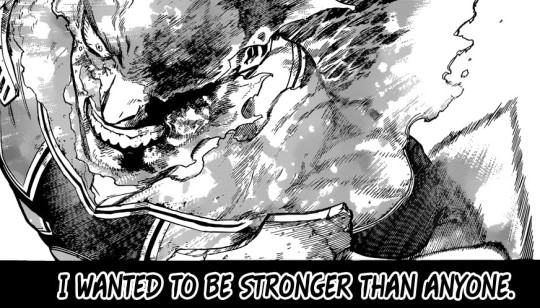
So how did I get to comparing the Egyptian sun god Ra to Endeavor? To sum it up, this is the fourth post in a set of analysis and meta about mythological influences in BNHA, so a lot of this builds on top of the info and connections I’ve made previously.
There are quite a few references and influences to Greek mythology in BNHA and personally I was very intrigued with the Hawks and Icarus parallels that kept popping up. In the myth of Icarus, the sun melts the wax off of Icarus’ artificial wings which causes him to fall and drown in the ocean. I saw Endeavor as one of Hawks’ metaphorical “suns”. While I sat on that, I began looking at Tokoyami, since he has a mentor-student relationship with Hawks, and found how he has Egyptian influences in his character design which I wrote about in a post here.
I began researching and reading through ancient Egyptian myths and information. One of the figures that caught my attention was the ancient Egyptian’s most important god: Ra, the sun god. (He is the falcon headed figure depicted below.) I quickly found some similarities between Ra and Endeavor.
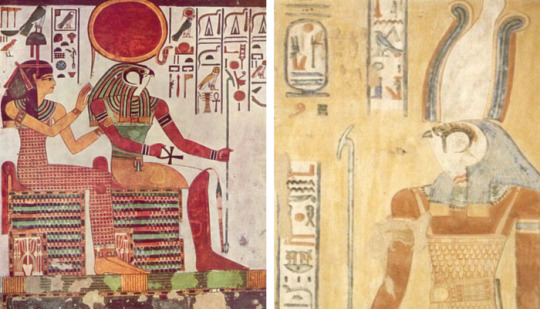
This image is from the expereince-ancient-egypt website.
Before I begin, I’d like to say I am very much aware that BNHA is a Japanese manga series and that the story is greatly influenced by Japanese culture and society. Unless there are very explicit examples (such as the case of Tokoyami) this post is not me saying that Horikoshi intentionally wrote certain characters and aspects inspired by Egyptian mythology. I just like like finding interesting similarities whether they were intentional or coincidental and writing about it.
That being stated, let’s begin.
Ra: The Egyptian God of the Sun
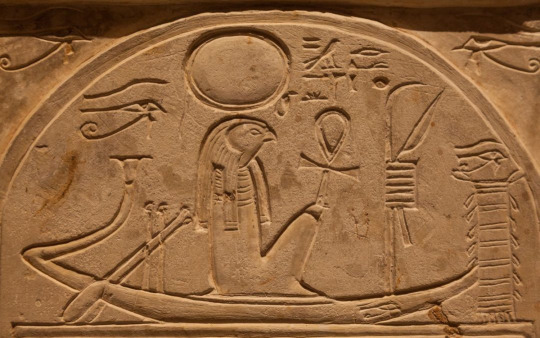
The original source of the image above is unknown.
So, who exactly is Ra?
Ra was the Ancient Egyptian sun god. The sun had a special place among the ancient Egyptians, they considered it the source of life. He was... the creator of the universe, one of the most famous deities...
Ancient Egyptians believed that Ra created himself, and his tears created humans. The setting of the sun means the beginning of the daily journey by Ra, in which he travels by his holy boat to the underworld every evening, to fight the forces of evil represented in a big snake called Apophis, and then returns to a brilliant triumph in the heights of the sky every morning on a new day. The ancient Egyptian saw this as a sign of human resurrection, and also evidence of Ra’s victory over the forces of chaos and evil (cleopatraegypttours).
Throughout all the websites I went through, Ra was very closely associated with the themes of the sun, life, the underworld, resurrection and victory over chaos and evil.
Let’s focus more on Ra’s journey through the underworld.
During his life he was required, as the incarnation and representative of the sun god, to maintain the cosmic and social order (ma’at) established by the god of creation. He had to repel the forces of chaos which constantly threatened the order of the world.
After his d/eath, the king united with the sun disk and his divine body merged with his creator. In his new role he continued to perform the task of subduing the powers of chaos. This active role of the king and sun god necessitated a detailed description of the d/amned, who represent the forces of evil.
Perhaps you may be starting to see the similarities and connections I began to form between Ra and Endeavor. If not, it’s okay. Sometimes II have to sit on a lot of the information I’m taking in before I see anything.
Endeavor’s Powers
Endeavor’s fire-based quirk is called “Hellflame.” The list of his named moves are: Flashfire Fist (Jet Burn, Hell Spider, Hell’s Curtain), Karmic Raze - Hellfire Storm, Raging Assault - Hell Minefield, Vanishing Fist, and Prominence Burn. As you can see, there’s a lot of mentions of the word: Hell.
While we can connect the “hell theme” back to Ra’s connections to the underworld, I would first like to point out what the Egyptian underworld was. We associate fire, suffering and other things with hell, however, this is a depiction that comes from the Abrahamic/Judeo-Christian religions.

The image above depicts a section of the Egyptian Book of the D/ead with Osiris on the left and the Weighting of the Heart taking place on the right.
There were many sources that described the extensive processes of the underworld and afterlife so I’m keeping it simple here. Anyways, the ancient Egyptians did not really have a concept of this sort of hell. Instead, after death, a part of the soul would travel through the underworld which was also known as Duat for judgement. They underwent a judgement process that had two parts and if they passed, they moved on to the Reed Fields which was Paradise. Those who failed simply ceased to be.
The “hell” that is probably being referred back to with Endeavor’s quirk and powers most likely was influenced with other cultures, again more specifically those with Abrahamic/Judeo-Christian religions. Despite this difference I do still think that there are other interesting similarities between Endeavor and Ra.
For example, I’ve already established in a previous post that I like to associate Endeavor to the sun. A lot of this post will rely heavily on what happened during the High End vs Endeavor fight. The move he is using above is called “Prominence Burn.” According to NASA:
a solar prominence (also known as a filament when viewed against the solar disk) is a large, bright feature extending outwards into the Sun’s hot outer atmosphere
This is the finishing move that helps Endeavor defeat the High End and this is very significant because it is the only move with a name that relates back to the sun.
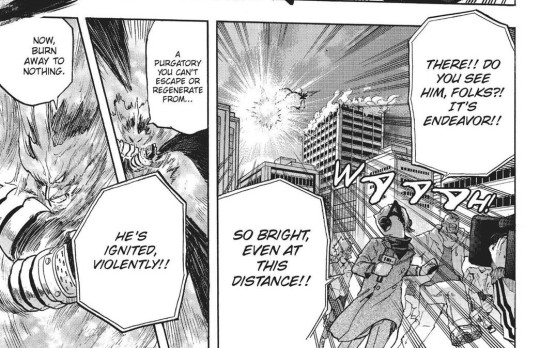
In Chapter 188 during the High End fight, Endeavor is even depicted as a fiery sphere of fire and light high up in the sky, very visually similar to the sun.
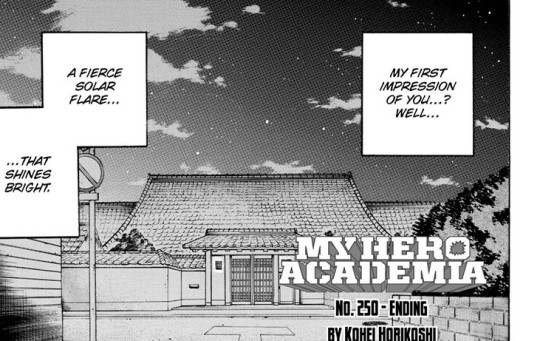
If you need more evidence for sun related themes surrounding Endeavor, Ending, the criminal who kidnaps Natsuo describes him as “A fierce solar flare that shines bright.”
One of Ra’s main duties is to keep order and defeat the “forces of chaos and evil.” Endeavor and the heroes in general sort of view themselves as this force of good and see the “villains” as enemies that have to be taken care of. I don’t agree with the ideas that “all heroes are good, and all villains are bad” and that is definitely not the message that Horikoshi is trying to send. It is because that sort of belief exists that hero society is flawed. Typically, when reading through mythology or religious texts, the themes of absolute good and absolute evil are common. Those are the contexts in which gods and other figures that exist. Humans are flawed and tend to stand somewhere in the in between.
That being stated, Ra and Endeavor are similar in their ties to the sun, underworld and sense of duty that they must defeat the “forces of chaos and evil” for the sake of everyone else.
High End vs Endeavor
Endeavor greatest ambition in life was to become the number one hero. He may act like a hero in the public’s eye but he does not have a “heroic nature” or “character.” He failed and broke his own family for the sake of his ambitions, and arguably, the Todoroki family came in to existence to serve a certain purpose. If he could not become the number one, then he’d make sure that someone with his blood and name would achieve that one day. However the unexpected happened. All Might had to retire and Endeavor was given the title as number one hero. He didn’t earn it. He was given it purely because he was the number two hero.
Let’s revisit the High End fight. This conflict happens shortly after the Hero Billboard Chart event. Japan is uneasy as their symbol of peace has retired and they do not know whether they can rely on the new number one hero. His family also is conflicted with his new position and how it was given to him. Throughout the fight we take a step in to Endeavor’s thoughts and inner monologue.
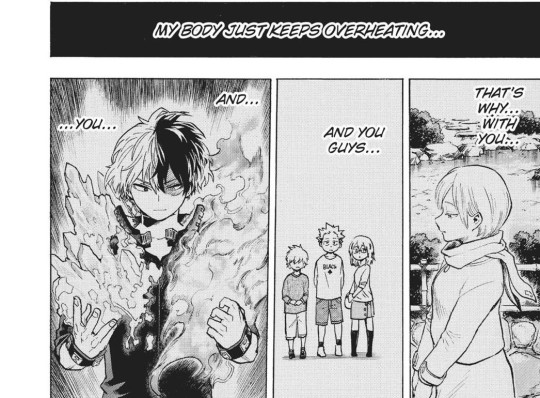
The manga panel above is from Chapter 188.
The High End is incredibly powerful and even with his powerful Hellflame quirk, Endeavor is having a hard time fighting against it. One of the weaknesses with having a fire related quirk is that it overheats his body so he’s had to rely on using his flames properly and cooling down afterwards. Because of this, he thinks about his family. The family that began because of this very weakness. His memory goes back to Rei when she is young, perhaps at the beginning of their arranged marriage or shortly before. Touya, Natsuo and Fuyumi are young as well. Standing far away and unhappy, maybe even nervous. And lastly, Shouto, the child he wanted to continue his legacy in, activating both his ice and hellflame quirks. He is the only one depicted in his actual current age.
On top of the very next page we get a scene with the High End Nomu speaking as seen below.
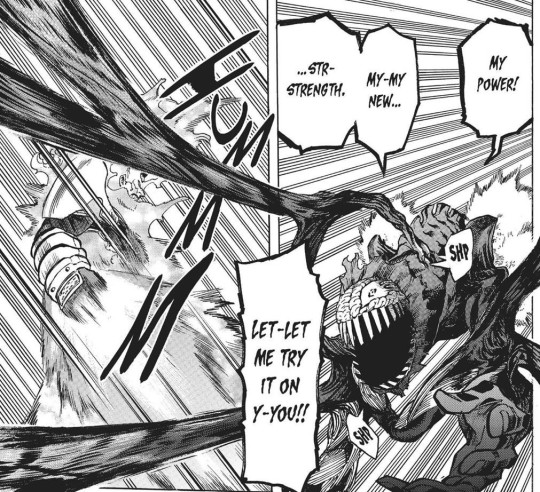
This Nomu came to fight and defeat whoever was the strongest. Despite it’s ability to speak, it is still mindless, declaring on and on about its power and strength. It does not care about who it is fighting and the destruction that is occuring along the way. The High End has multiple quirks that were chosen specifically to make it as powerful as it could be. Perhaps it was in this moment that something clicked in Endeavor’s mind.
Soon after, the High End strikes Endeavor multiple times, with one strike later leaving him with the scar that runs down the left side of his face. He falls to the ground and in to the rubble. Chapter 188 ends on this page with the manga panel seen below and everyone is left to wonder whether Endeavor is dead or alive.

In Chapter 189 we see the effects of the void All Might left due to his retirement.
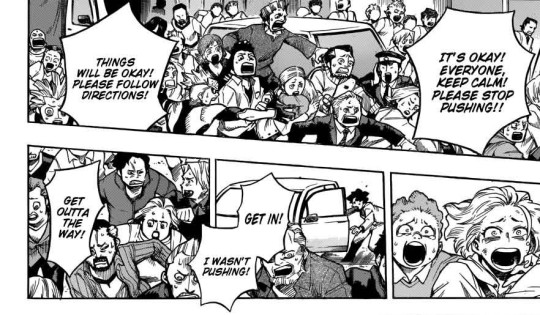
If the “villains” can’t be kept in check the public becomes chaotic with fear. A quiet night fell over Japan after All Might retired. People felt like the light was taken away. Then Endeavor gets up. With Hawks’ help he rises in to the air with wings on fire.
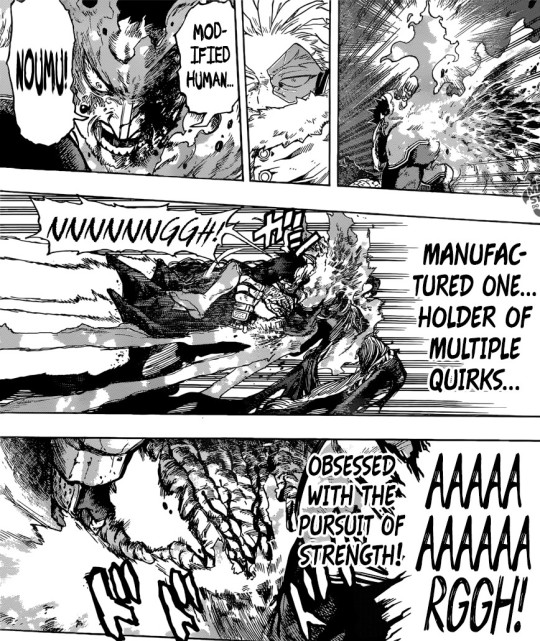
And in Chapter 190 he defeats the High End Nomu with Prominence Burn.

Endeavor and the Dawning Sun
There’s a lot of things going on here. Endeavor basically follows the journey Ra takes every single day to complete his duty. Similar to how Ra “dies” as he travels through the underworld, at one point we are led to believe that Endeavor has been killed by. As most of the battle took place up in the air, Endeavor physically falls when he “dies.” Leading up to the fall, he is thinking about his family and the past.
While Ra and Endeavor “resurrect” at different points in their journey, they both rise back again in order to fulfill their duty to bring back “order and balance.”
I’ve already written about the falcon/hawk headed Egyptian god Horus and Hawks, however I have yet to address the relationship between Ra and Horus. At some point, Ra was combined with Horus and became known as Ra-Horakhty which means “Ra, Horus of the Horizon.” Ra-Horakhty is most often thought of as the god of the rising sun. It is in this form that Ra rises in the sky to bring the dawn when he arises from the underworld.
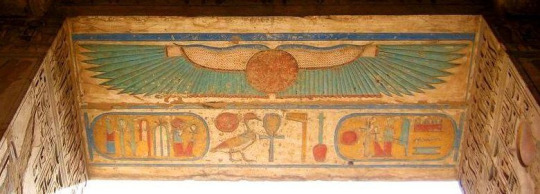
The original source of this image is unknown.
There is a deity (seen above) that appears a lot throughout architecture from ancient Egypt called “Horus-Behdity” who is depicted as a winged sun disc:
The winged sun disc is highly symbolic representing the Union of Horus the falcon God, and Ra the sun god, the union of the Two-Lands of Egypt, and becomes a symbol of rebirth for the kings (British Museum).

Although it is Endeavor who ultimately defeats the High End, it is with the aid of Hawks’ quirk that he is able to land the finishing blow. He rises in to the sky like the winged sun disc: Endeavor as the sun, and Hawks as the wings. I think the depiction of Hawks with his back towards he audience and Endeavor burning them with his flames on the cover of Volume 21 says a lot of things (including the Icarus parallels!).
Taking a couple steps back, the wording on the pages where Endeavor addresses the nomu and then before uses the finishing move Prominence Burn on the High End is important.
“Modified human... Noumu! Manufactured one. . . Holder of multiple quirks. . . Obesessed with the pursuit of strength!” (Chapter 190)
“You are... Just like me! From the past, or perhaps from an alternate future. Now burn, and rest for all eternity!” (Chapter 190)
Endeavor is a controversial character that because of his past and the horrible things he did to his family. However, we can not ignore what has been written in the manga. I’m not going to argue or talk too much about my own thoughts and opinions here, but I think it is important to address what happened during this High End fight.
He identifies himself with the Nomu: the power hungry and mindless creature. It’s interesting that he uses the phrases of “manufactured” and “holder of multiple quirks,” and “pursuit of strength” which are words that are heavy with meaning to him: the arranged marriage he purchased, the children he neglected and the “perfect” child he sought after for the sake of strength.
The train of thoughts that had begun in his mind is expressed outwards. He shouts them out in to the sky. He acknowledges the past (however to what extent is debatable), and even addresses the future. I’m not sure if he’s acknowledging that he may fail to change or that he hopes that he can change what he can.

He then defeats the High End. Endeavor had been given the number on hero position but this victory is what “establishes” him with the title in the eyes of the public. With the bright light of All Might gone, the public is inspired by a new light, the sun that Endeavor represents bringing a dawn to the night. His victory pose is reminiscent of All Might’s however it is with his other arm that is in the air, he’s slumped over and his legs are barely keeping him up. The flames that usually cover his face and body are gone as well. This is the victory of Endeavor the hero but it could also be Todoroki Enji as a father making a statement.
I’m not sure if this is him symbolically k/illing the monster he was, or if this is symbolic as to where Endeavor’s journey will ultimately head towards, or if its a representation of hopes that never come true later on. I’m not trying to paint this piece from a pro-Endeavor stance or an anti-Endeavor stance but merely trying to explain how I interpreted the events of the High End fight and the thematic meanings it had as it unfolded. At the end of the day, we all have different opinions and interpretations and you have all the right to disagree with everything I’m writing in this post.
(The case with Endeavor is very complicated and I don’t want to get to deep in to it here however) We definitely should not forget what Endeavor did in the past but at the same time we should not ignore the efforts and progress he has tried to make. While we must hold people accountable for their actions, it is not wrong for someone to want to change or become better. Endeavor may “fail” or he may be able to “succeed,” whatever either entails or looks like. However even though we do get the depiction of a rising sun, you have to remember that the sun also sets.
Anyways, what has been established was that this fight is where Endeavor explicitly expressed his acknowledgement of the past (maybe not in its entirety but it is a big first step). And it is directly after this step that we take a deep dive in to what facing the past will look like for Endeavor.

#endeavor#todoroki enji#hawks#takami keigo#bnha analysis#mha analysis#mythological influences#bnha meta#mha meta#dabi#todoroki touya#todoroki family#todoroki shouto#luna writes#my post
59 notes
·
View notes
Text
Ariadne and why the Mycenaeans can fuck right off
Warning: Includes brief mentions of r*pe, cultural destruction, ancient patriarchy reminding us why no woman would ever time-travel more than 5 years into the past if that and a great deal of spite for male historians/public education history/mythology classes.
Possible side effects may include a sudden intense rage for an ancient society equivalent to the innate rage one has for the Romans burning the library of Alexandria, a distinct hatred for ancient men not being able to let anyone have nice things, and a sudden fascination for Minoa.
Usually, I stick to writing imagines and being happy with that. It’s fun! I love it! But every now and again, in an attempt to escape the crushing forces known as reality and responsibilities I’ll put on a few cutscenes from games I’m: A) Too lazy to play B) Too broke to play C) Too unskilled to play D) All of the above
because cutscenes are free and why torture yourself with impossible levels when its free on Youtube?* *In all seriousness please support video games and video game creators, but no shame to those of us who prefer cutscenes to gameplay. A few weeks ago I added the game Hades made by Supergiant to the list because the cutscenes were bomb and the characters are so much fun! Intricate as all hell! Hella cute too but that’s unrelated! Now my pretty little simp patootie is especially a big fan of Dionysus and his gorgeous design so the cutscenes with him are my favorite.
I’m re-watching his cutscenes a few nights ago for fun as background when he has a certain line about Theseus. Don’t quote me on this since my memory is foggy at best but roughly it was: Dionysus: Good job with Theseus. Never cared much for him- what he did to that girl was just horrible.*
*I know that’s not his exact line but this is clearly a rant post fueled by spite and ADD-hyper-focused obsessions with ancient civilizations so let’s not worry too too much about the semantics here.
Now, I like mythology! Personally, I prefer the Norse mythology due to the general lack of very very gross dynamics that several other ancient mythologies seem to include, but I’m decently familiar with Greek mythos. Enough to go - “Why does the God of Wine give a single fuck about the frat bro of Greek heroes being a dick to a woman? Grossness is embedded into the very DNA of all distant relatives of Zeus, a woman being harassed by Zeus or his bastard army is a typical Tuesday in ancient Greece.”
Wikipedia confirms that Ariadne is the only woman in the story of Theseus and the Minotaur, which I kinda knew already so unless Theseus did some f’ed up shit to some other princess of Minos, Dionysus could only be referring to her. Disregarding what I know about Wikipedia and how it can suck you down the rabbit hole of rabbit holes through sheer fury I stupidly clicked the link to Ariadne’s article.
By the time we get to the end of this shitstorm, I will have two separate plotlines for two separate stories based of Ariadne, 2k+ notes (and going) on an ancient civilization prior to a week ago I didn’t know existed and within me there will be a rage towards a different ancient civilization I vaguely recall learning about in high school.
Here’s how this shit went down.
First of all, apparently after Theseus abandoned Ariadne on an island to die (yep! He did that! To the one person who is the only reason he defeated the minotaur! Fuck this guy.) there are multiple storylines where Dionysus takes a single look at Ariadne and falls in love.
“A god falls in love?” you say, aware of how most love stories in Greek mythos can be summed up with Unfortunately, Zeus got horny and Hera is a firm believer in victim blaming. “This poor woman is about to go through hell!” I thought so too! And in one variation of the story, Dionysus does his daddy proud by being an absolute tool to Ariadne. In the majority though? He woos the fuck out of her, and ultimately marries her by consent!
Her consent!
In ancient Greece!
The party dude of the Greek pantheon knows more about consent then his father and modern day frat brothers!
Okay! That’s interesting, so I keep reading.
Ariadne getting hitched to Dionysus is a big deal in Olympus, to the point of getting a crown made of the Aurora Borealis from Aphrodite who is bro-fisting Dionysus, beyond glad she didn’t have to give him the talk about consent. The rest of the gods are pissy especially Hera who doesn’t like Dionysus much since he is the son of Zeus and Semele but they don’t do much. Ariadne ascends to godhood, becomes the goddess of Labyrinths with the snake and bull as her symbol and that’s that on that.
Colorin, colorado, este cuento se acabado. And they lived happily ever after. That’s the end of the post right?
NO! Because curiosity has made me their bitch and there’s more to this calling me.
Also, I was pissed! Still am! Why the fuck-a-doodle-do did I have to learn about the time Poseidon r*ped a priestess instead of the arguably healthiest relationship in the entirety of the pantheon? Why is Persephone and Hades’ story (which has improved since it was first written and I like more modern versions of it, no hate) the only healthy-ish Greek love story I had to learn when Dionysus and Ariadne were right there? The rage of having endured several grade levels of “Zeus got horny and Hera found out” stories in the nightmare of public education led me to keep looking into this.
There’s this wonderful Youtube channel called Overly Sarcastic Productions that I highly recommend that delves a lot into mythology, and I have seen their bombass video about Dionysus and how his godhood has changed since he was potentially first written in a language we comprehend.
Did ya’ll know this man is the heir apparent to Zeus? ‘Cause I didn’t know that!
YEA! Dionysus, man of parties, king of hangovers and inducer of madness, is set to inherit the throne of Olympus! Ariadne didn’t husband up the God of Wine, she husbanded up the Prince of Olympus and heir apparent to the throne! Holy shit! No wonder some of the gods were against her marriage to Dionysus - can you imagine the drama of an ex-mortal woman sitting on the Queen’s throne of Olympus? Hera must have been pissed.
BUT WAIT.
There’s more.
The reason we know Dionysus is a very important god and is possibly even more important than we think is because of a handy-dandy language known as Linear B, otherwise known as the language of the Mycenaeans!
For those of you fortunate enough to have normal hobbies and interests, the Mycenaeans were the beta version of the Greeks. Their written language of Linear B is one of, if not the first recorded instance of a written Indo-European language. This language, having been translated, gives us an interesting look at what the Greek gods were like back in their beta-stages before they fixed the coding and released the pantheon.
Interesting side facts of the Mycenaean Greek gods include:
Poseidon being the head god with an emphasis on his Earthquake aspect, and being much more of a cthonic god in general.
Take that Zeus, for being so gross.
The gods in general being more cthonic, as Mycenaeans were obsessed with cthonic gods (probably due to all the earthquakes and natural disasters in Greece and Crete at that time)
Several of the gods and goddesses that we know being listed, alongside some that we don’t consider as important (Dione)
The first mention of Kore, later Persephone, but no Hades because since a lot of gods were cthonic, there would be no need for one, specific cthonic god to represent the majority of death-related rituals.
That’s not what we’re focusing on though! What we’re focusing on is a specific translated portion of Linear B that we have. One of the translated portions of Linear B that for the life of me I can’t find (someone please help me find it and send the link so I can edit this post) says an interesting phrase. “Honey to the gods. Honey to the Mistress of Labyrinths.”
One more time. “Honey to the gods. Honey to the Mistress of Labyrinths.”
Mistress of Labyrinths.
Now wait a gosh darn minute. Isn’t there a goddess of labyrinths in the Greek mythos? Why yes! Yes there is! Ariadne!
Here’s a question for you. If Ariadne is but a minor god in the pantheon, a wife to a more predominant god, why is it that while all the other gods and goddesses are bunched together in a sentence of praise, the so-called ex-mortal gets a whole-ass sentence to herself singing praises?
And thus, we have arrived to Minoa!
What is Minoa, you ask? Minoa is to Rome what Rome is to us. An old-ass civilization either older than or younger by a hundred years to ancient Egypt. Egypt, that started in 3200 B.C-ish depending on who you ask. That’s old. Old as balls. They were contemporaries to their trading partner, Egypt until 1450 BC-ish. A 2000 year old civilization.
Minoa was founded on the island of Crete, and was by what artifacts we have found a merchant civilization with its central economy centered on the cultivation of saffron and the development of bronze/iron statues of bulls. Most of what we know about them comes from artifacts and frescoes found on Crete that managed to survive everything else I will mention later, but what matters is that we know a few things about them.
Obsessed with marine life for some time, given their pottery.
Had the first palaces in all of Europe, some of them ridiculously big.
Wrote in Linear A and Cretan Hieroglyphs, both still untranslated languages.
Had a ritual involving jumping over a bull, for some reason.
Firm believers in “Suns out, Tits out.”
You’d think I’m kidding on the last one but no! No no no! All the women apparently rocked the tits-out look in Minoa!
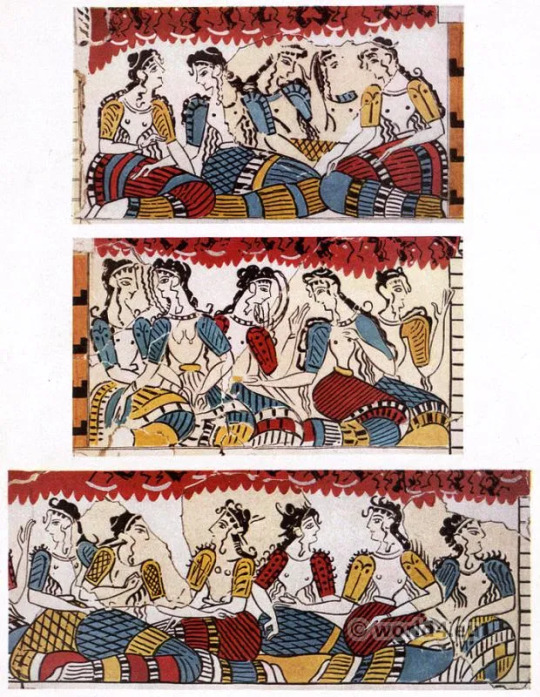
^^^^One of many, many Minoan works featuring women giving their titties fresh air. ^^^^
“Wait a second Pinks! What does this have to do with Ariadne being the Mistress of labyrinths?”
Well you see dear wonderful darling, while we know very little about Minoan religion because Mycenaeans (we will get to those bastards in a second), we do know this:
All the religious figures appear to be exclusively women.
The most important figures of their religion seem to be goddesses as there are few artifacts featuring male gods.
Because of the religion, the culture may have been an equal society or even a matriarchy! Historians who are male aren’t sure.
A frankly ridiculous amount of their temples, including the ones in caves in the middle of fuck-all feature labyrinths. A lot of labyrinths!
Their head god is a goddess! Whose temples have labyrinths and whose main symbols are snakes and bulls. Who do we know is a) the mistress of labyrinths and b) is symbolized a lot by snakes and bulls?
ARI-fucking-ADNE THAT’S WHO!
Ariadne didn’t upgrade by marrying the prince of Olympus! Dionysus wifed up possibly the most important goddess in all of Crete and becoming her boy-toy!
I’m not even kidding, most Minoan depictions of the goddess’ consort features a boy/man who cycles through the stages of death. Dionysus himself in several myths goes through the same cycle - life, being crushed, death, rebirth, repeat. Cycles the consort goes through in Minoan legend depictions too!
Okay, that’s great, but what does that have to do with the Mycenaeans? Why do you want to single-handedly go back in time and strangle the beta-Greeks with the nearest belt?
Everything I just said about Ariadne being a Minoan goddess, the Mistress of Labyrinths being hella important on Minoa, is all theoretical. The Mycenaeans are partially to blame for making it theoretical.
Minoa thrived for 2000 years but it had a lot of issues, mostly caused by natural disasters. Towards the end of their civilization (1500 BC-ish), the nearby island of Thera, today known as Santorini, decided to blow up. The island was a hella-active volcano that when erupted, destroyed a lot.
How big was the eruption? Well when Pompeii was wasted by Mt. Vesuvius, the blast was heard from roughly 120 miles away, 200 km.
The blast on Thera was heard from 3000 miles away. 4800 km away.
Fuck me, the environmental effects of the explosion were felt in imperialistic CHINA.
Holy shit that would waste anybody! And it did! Minoa went from being a powerhouse in the Mediterranean to scrambling to recover from losing 40,000 citizens and who knows how many cities. Tsunamis may have followed the blast, further destroying ports which for a navy-powerhouse of an island nation is a bad thing and the theorized temperature drops caused by a cloud of ash lingering for a while would have destroyed crops for the year.
Minoa was fucked.
The Mycenaeans and all their bullshit made it worse.
Up until a few hundred years prior to Thera’s explosion, Minoan artifacts don’t depict much in terms of military power. Why would it? Crete is a natural defense post. Sheer cliffs, high mountains and a few semi-fortified areas would make it pointless to invade. It’s only when the Mycenaeans in all their bullshit decided to attack/compete that Minoa really needed any army to speak of.
Guess who decided to invade while Minoa was reeling from an incredibly shitty year? Mycenaea!
Guess who won?
Also Mycenaea!
Nobody knows how this shit went down though because wouldn’t you know it, the Mycenaeans in all their superiority-complex glory decided to destroy most written accounts about Minoa, a good junk of the temples and culturally eliminated most of Minoan beliefs.
Minoa isn’t even the real name of the civilization! It’s just the name Arthur Evans, the guy who re-motivate interest in Minoan archaeology, gave to the civilization because the writings that would have included the name of the civilization were destroyed.
“That sucks!” Fuck yes that sucks! “What does that have to do with Ariadne though?”
Oh ho ho. Strap in because you’re about to be pissed.
Those of us unfortunate enough to be aware of all the bullshit the Christians pulled on the European pagan belief system are familiar with the concept of cultural, religious destruction. There’s a special name for it I don’t know but if I did I would curse it to be absorbed by the horrendous will of fungi.
An example: Christianity was not the most popular of religions amongst the Vikings. A monotheistic religion that is heavily controlled did not strongly appeal to anyone with a pantheon as rad as the Norse one.
In order to appeal to the Vikings, what monks would do is they would write down traditionally Viking stories which up until that point were orally passed down. Beowulf, the story of the most Viking Viking to have every Vikinged, was one of these first stories.
However! Did these monks write Beowulf as closely to the original oral transcript as possible? Of course not! They took liberties! While Norse features such as trolls and dragons and all sorts of Norse magic occur, there is a lot of Christian features added in.
This happened across all Pagan religions that Christianity came into contact with in Europe. Stories would be altered when written down to be more Christian (this happened to the Greek Pantheon too btw), holidays that were Pagan magically lined up with ones the Vatican just happened to suddenly have. Even names of mythological figures were taken and added onto Christian figure names. Consequently, a lot of pagan religions they did this to got erased over time, with many of their traditions and details being lost forever, and the details we do know being tinted by Christianity.
The Mycenaeans were likely no different.
Minoa and Mycenaea were as culturally opposite as can be. Minoa is theorized to be a matriarchal or equal society*. Mycenaea and most of early Greece absolutely was not. In fact, during early stages of their religion where they believed in reincarnation, the Mycenaeans believed the worst thing to come back as was a woman.
Did you get that? With your options ranging from man to ever single animal on Earth, a woman was ranked as beneath literal animals in Mycenaean society.
Fuck the Mycenaeans.
* This is not to say Minoa was without fault, as a society that is matriarchal or equal can still have rampant issues such as privilege, classism, racism, sexism and more, but when history has a shortage of civilizations that didn’t treat women like shit, you find yourself rooting for them more.
What do you do then, when you take over a society that is very much the opposite of a nightmare of a patriarchy? You fold their beliefs into your own to bait them into yours. Going back to the Linear B line about “Mistress of Labyrinths” that line would/could have been an early tactic of incorporating Minoan belief into Mycenaean belief. Other goddesses and gods were made into aspects of Mycenaean gods. Bristomartis, the Minoan goddess of the hunt, would become Artmeis. Velchanos, a god of the sky, would become Zeus.
With more time, the religion shifted more into Mycenaean and eventually into ancient Greece as we know it. Through trade other gods and goddesses would continue to shift and change, some being straight up imported (Aphrodite for example). Dionysus himself changed a lot too, going from a God representing freedom and attracting slaves, women and those with limited power into his cult, to a God of parties for the wealthy.
Theseus and the Minotaur was a myth likely based on a Mycenaean myth based on a Minoan myth that changes Ariadne from an important, possibly the important goddess of an ancient religion and relegates her to a side character in a pantheon so vast that she would be lost within it.
All of this brings us to today. Today, where as soon as work ended I spent most of the day, as well as the past two days, looking up everything I can on Minoan civilization and added it to my notes. Spite is fueling me to write two possible different stories for two different fandoms where Minoa dunks of Mycenaea and it is giving me life. Expect an update within the next two weeks folks as I lose control of my writing life once more.
In summary: Ariadne deserves more respect, fuck the public education system for skipping over the good parts of Greek mythology instead of the r*pey as shit parts, the Mycenaeans can eat my shorts, and a world were Minoa became the predominant power instead of Greece would be an amazing world to live in.
Thank you for coming to my TedTalk. Pink out.

#minoa#minoan#crete#ancient history#ariadne#mycenaea#mycenaean#I hate#HATE#HATE HATE HATE the Greeks so much#homer is a dick#So much spite and curiosity went into this#if I ever get a time machine I will travel to the first years of Mycenaea for the express purpose of burning it to the ground before#they get a chance#the opportunity#to look at Minoa wrong
141 notes
·
View notes
Text
Asterix and the Legacy of the Original Authors
So I finally saw Asterix and the Secret of the Magic Potion (2018). Significantly, this is the first Asterix story I’ve experienced since the retirement of Albert Uderzo, the original co-creator of the characters and creative lead follower the death of Rene Goscinny.
And it was brilliant.
The plot, simply summarised, is that Getafix (Panoramix in the original French), venerable and wise village druid, slips and falls out of a tree for the first time in his long career. He begins to worry that he’s getting too old for this (indeed, Getafix’s age has always been ambiguous, but he’s easily the oldest recurring character after the appropiately named Geriatrix/Agecanonix, who’s certainly over 80), and that he needs to find a successor, not least of which because only he knows the formula for his legendary magic potion that gives the Gauls the super strength needed to hold off the Roman invasion (the film makes a running joke that druids never write things down). While on the search, an old rival of Getafix’s, Sulfurix (dubbed Demonix in the Canadian English dub, in case it wasn’t clear that he’s evil) is desperately trying to steal the formula, seeking to liberate the Gaulish lands from the Romans and not merely one village. Along with Asterix, Obelix and tagalong kid Pectin(/e), the heroes must find a successor, but is there a Gaulish druid worthy of this most sacred knowledge?
The animation is excellent, as it was in the previous animated outing Asterix and the Mansions of the Gods (2014), really capturing the look and feel of the comic albums. I feel like too much cartoon media these days is afraid to really exploit squash-and-stretch for expressive and dynamic purposes, and with Asterix’s trademark slapstick being Roman soldiers clobbered so hard their torsos sail off into the air before their feet have entirely realised what happened, it was necessary for this. The film is bright and crisp, and the light effects suitably dramatic (and with many a magical zip and zap, it’s crucial to have good lighting).
The story has many of the familiar beats. Alexandre Astier is clearly playing it a little bit safe, but considering he’s writing his own Asterix story, it’s safer to stick with that than to try and push it too far and risk alienating the audience. A crisis emerges, Asterix and Obelix and miscellaneous tagalongs leave the village, shenanigans happen, Asterix and Obelix have a falling out and become separated temporarily, there’s an ominous moment when the magic potion runs out, Romans attack the village, everyone gets back in time to save the day, Romans get punched a bit, big feast under the stars. What I liked, though, is how this story tried to do something interesting with the side characters. While Getafix is a very important character for the story, he rarely gets involved in the actual plot, so it’s nice to see more of him and in particular his character flaws - namely his stubbornness and attempts to do everything himself, even to the detriment of those around him. Even being confined to a primitive wheelchair for a lot of the film due to an injured ankle doesn’t stop him from taking a part, and it’s nice to see more of him than merely ‘wise wizardly old man, keeps calm and lectures people’. Unhygenix the fishmonger (Ordralfabetix) gets an amusing background arc where he believes that he could be Getafix’s successor and tries dabbling with druidcraft in the background, with amusing results. For once, his role isn’t just ‘gets in a fight with Fulliautomatix the blacksmith (Cetautomatix)’, and we get to see that he’s an interesting combination of surprisingly intelligent and thick as two short rocks. Fulliautomatix himself gets to have some humorous musing at his alchemical antics, and at one point the requisite Unhygenix/Fulliautomatix fight is successfully quelled, with Fulliautomatix admitting that he has a short temper and that this was unnecessary aggression on his part. Vitalstatistix (Abraracourcix) leads the village men (apart from the perennially unpopular bard Cacofonix (Assurancetourix)) to accompany Getafix halfway through, leaving the womenfolk to defend the village with a backup supply of potion. Happily, this means we also get to see more of the village women - headed up by Impedimenta (Bonnemine), Mrs Geriatrix (Geriatrix’s unnamed but incredibly young wife) and Bacteria (Ielosubmarine) - than just ‘being someone’s wife’ - Impedimenta plays a vital role in corralling the women for war and appears to be keeper of the potion reserves, while the others get more speaking roles and are able to participate in fights. It’s not much, but in a world of Gaulish men, the women tend to fall by the wayside unless they get to be a sex symbol or someone’s harridan wife. Cacofonix himself gets to play at being a chief, where his cowardly nature makes for an amusing contrast Impedimenta’s more no-nonsense practicality. We also get to see some of the Gaulish children for once! They make fun of their elders and play around with stolen Roman warrior stuff. When the going gets tough, though, the first thing the village defence team do is make sure the kids get somewhere safe, and Cacofonix gets a slightly tender moment where he tries to assure them that he’s going to be okay ... with a long winded speech rather than just getting on with it.
The real star of the film (well, alongside Asterix, Obelix and Getafix) is Pectin. Pectin is a scrappy little girl from the village who’s into inventing and engineering, and her establishing scene is ignoring the other kids playfighting so that she can finishing what seems to bee some kind of automatic watering machine. She’s smart, creative, appropriately afraid of the dangers that crop up but wants to do right by Getafix, whose wisdom she deeply admires. It’s fairly clear even from the outset what her role will be. Eventually, in the darkest moments, Getafix teaches Pectin the secret recipe - including Getafix’s secret ingredient - in order to save the village. She assures Getafix later that she will try to forget the recipe, so that she won’t accidentally reveal it to the wrong sort, but just as the credits roll, Getafix muses what we’re all thinking - that this girl might be worthy to be his successor. Pectin’s important because of the series’ ... shaky history with feminism. The film sets out that only men can become druids, and women are even forbidden from the woods where they meet. When taking Getafix to the meet, Pectin has to wear a hood and hike her dress up to look more like a boy appropriately. To allow Pectin to become a druid would defy ... well, some lofty ideal that only men can become druids. Like so many old sexist tropes, the reason has become ‘... well, they just don’t’. So it’s good that this is addressing that, as well as forcing more female characters into the limelight. The most prominent female character in all of Asterix is Impedimenta, followed maybe by the heartthrob and Obelix’s crush Panacea. I’ve elaborated above the problems there. In Asterix classic, women are to be desired or to be overbearing wives to henpecked husbands. It’s likely that Goscinny and Uderzo meant no malice by this writing; they were two French men writing a humour comic, and played on the popular tropes accordingly. But they (or rather, Uderzo) did attempt to tackle feminism in this comic before. It was ... well, it was a bit clunky.
Asterix and the Secret Weapon (1991) was a rather dated and fearmonger-y take on feminism, having a feminist activist outsider called Bravura comes to the village, encourages the women to rise up against their husbands (the men, out of chivalry and hen-peckedness, do not resist), seizing control of the village. Asterix, being both a bachelor and bit of a firebrand at perceived injustice, confronts Bravura, whereupon she flirts with him to try and seduce him into marrying her, whereupon he (shock horror) strikes her out of reflex. But Gaulish men do not hit women! Asterix is banished to the nearby forest for his insolence, eventually joined by the other men, fed up with the overbearing women. When the Romans (knowing that Gaulish men will not attack a women) send a detachment of female soldiers to the village, the women have turned it into a primitive shopping centre, where the female soldiers can shop and get their hair and make up done and forget all about attacking the village. Yeah. Feminists are salacious witches who would enthrall men and subjugate them, women love nothing more than shopping and beauty, it’s ... it’s bad. Secrot of the Magic Potion at least attempts to fix this by questioning male dominance in a role without being so weird about it, and having the women be just as much proud, organised village defenders as the men, arguably more so, given they lacked the weapons or numbers they normally had with the men around. (I know that the most recent album, Asterix and the Chieftain’s Daughter (2019), kinda deals with this too, but I haven’t yet read that one)
Putting aside the feminist rant, the key theme of this film seems to be the passing of the torch, clinging to past glory, and stepping up to take responsibility. Getafix isn’t getting any younger, and as much as might hurt his pride, he needs to train someone to take his place. The other elder druids, it transpires, are foolish, complacent and irresponsible, getting too used to just messing around and partying. They’re getting senile too, shamefully admitting to keeping crib sheets to remember which apprentice druids are any good. Druids not writing things down seems to be a metaphor for old masters, well versed in their craft, who know it all so well that they don’t need notes ... and then struggle to teach others, so they keep doing it all themselves. Sulfurix is bitter that, despite his magic fire being useful, Getafix is held up as the better druid. Way back when, they were finallists in a druidcraft competition, and being able to conjure flame from nothing is certainly a useful talent that won out over Getafix’s useless but dramatic and very complex magic. Getafix is implied never to have held a grudge over this, especially given that he would eventually develop the magic potion that makes his people so formidable. Sulfurix, meanwhile, found his ‘useful’ parlour trick get weaker and less reliable over time, and he seems to have very few tricks under his belt by the present, so fixated was he on this one thing. His Villain Rant at Getafix at the end is pure projection - he’s become irrelevant, because his one thing became all he was known for. Finally, with Cacofonix being acting Chief, the women defending the village, and Cholerix (Teleferix) the apprentice druid and later Pectin striving to create the magic potion and fill Getafix’s footsteps, there is a theme of people, even wildly unprepared people, stepping up to take responsibility because it’s what needs to be done, be it for the sake of a legacy or simply because this operation won’t run itself. Such a theme rings loud in, I remind you, the first original Asterix story on film since the death or retirement of both of the original creators. They’re on their own now, with a great and beloved legacy to continue, and I think they’ve done a wonderful job. The film was not perfect by any means - the English dub lip-flaps weren’t that well aligned (my DVD didn’t have French language options), the story’s quite formulaic if you’re a fan of the series, and Sulfurix is ... not subtle as the villain - but if you like Asterix, you’ll like this. And if you don’t care for Asterix, it’s still enjoyable.
#asterix#asterix and the secret of the magic potion#not often a film makes me want to immediately write a review
19 notes
·
View notes
Text
How to Actually Play Magic: The Gathering
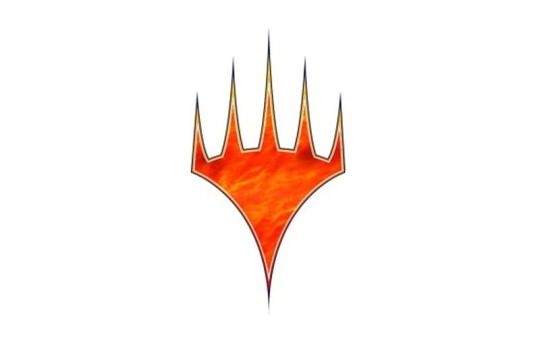
Magic: The Gathering (MTG, or just Magic) is the first and one of the most popular trading card games in the world. Described as the chess of card games, you can go as complex as you want (even make a computer) or have as much fun as you want, diving into the multitudes of worlds, creatures, and characters to express yourself.
But first you need to know how to play.
Lots of guides tend to be overly simplistic, so here I’ll try to go really in-depth in the rules while still maintaining an introductory tone. I will also try to provide as many pictures of relevant cards as possible to expose you to the vast array of effects cards may have, and how they interact with what I’m currently discussing.
1. The Colors of Magic

The most defining part of Magic are the five different colors. Each has its own flavor, playstyle, advantages, and disadvantages. You can combine different colors in your deck to have access to interesting combos and to balance out your deck’s weaknesses. Different color combinations also have their own specific flavor, often embodied by groups such as the guilds of Ravnica.
White: This is the color of unity, healing, and order. Cards in this color will often gain you life, protect your creatures from damage, tax or outright prevent your opponents from doing tricky things, and make armies of small creatures that together make mighty fighting forces. It is also associated with artifacts, enchantments, and exiling.
By the way, I will be defining Magic terms as they come up, like so.
Token: A representation of a creature, artifact, or something else. You can use it like a card while it exists, but it will vanish when it leaves the battlefield. (the rest of these terms will come up soon.)
Exile: Originally called “removed from the game”, exile is a zone that is inaccessible to most cards. It makes sure your opponents’ creatures go away forever. Sometimes, creatures go to exile and come right back to get extra enter-the-battlefield effects, known as blinking.
If you see something that isn’t immediately defined, just keep it in mind. Chances are I’ll cover it in a later chapter.
Blue: This color is related to knowledge, water, and the cold. You’ll get to draw lots of cards, but your creatures will be lacking. Instead, you will have access to powerful spells that bounce, freeze, or steal your opponents’ creatures and even give you extra turns. Quelch your opponents’ attempts with counterspells. It also has affinity for artifacts.
Black: This color represents death, disease, and ambition. Full of evil kill and discard spells, you will have access to your own army of zombies, vampires, and demons. You will also be able to do powerful things, but often at the cost of cards, creatures, or even your own health. In the words of Dark Confidant, “Greatness, at any cost.”
Red: This is the color of passion, fire, and explosive power. Many of the direct damage spells, including the iconic Lightning Bolt, are Red, as well as aggressive, fast creatures and multiple combats. You will have an extreme upper hand in your first few turns, but will quickly run out of gas if you don’t use another color to keep up on card draw. Red also brings with it mighty dragons and world-morphing chaotic effects.
Green: The color of nature, Green is similar to white in its abilities to heal, create tokens, and destroy artifacts and enchantments. However, Green has a wild side and is full of giant beasts, swarms of bugs, and rapid evolutions. It also brings out lands quickly and makes tons of mana.
2. Dissecting a Card

Sidisi is a popular character that hales from the plane of Tarkir. She’ll be helping us as a prime example of what a card looks like. There’s a lot to take in, but we’ll start from the top and work our way down.
First is the border (yes, from the very top!). It seems silly, but there are actually a few different borders that mean different things. A vast majority of cards have the regular black border. You may also see cards with white borders - these tend to be older cards, but they’re just as good as the black bordered ones. Silver borders come from the Un-sets, a series of joke sets full of wacky mechanics and inside jokes. None of these cards are tournament legal, but you’re free to have fun with them with your friends. Gold-bordered cards will also have a different back, and were printed as a part of tournament-winning decks back in the day. These are not tournament legal, but since they are often cheaper than their “real card” counterparts, people will use them in casual decks.

Next is the name. “Sidisi, Brood Tyrant” is the full, English name of this card. Each deck can only have up to 4 copies of any single card (there are very important exceptions to this I will cover in the next chapter). There are also a few cards which specifically reference others by name.
To the right of that is the mana cost. In this case, we need to use one black mana, one green mana, one blue mana (each represented by their respective symbol) and one mana which can be of any color, or even colorless, represented by the 1 in the circle. We’ll find out how to get mana in the next chapter as well. As a side note, many cards will consider the mana value (formerly, converted mana cost), which is just the total cost of the card as a number. For Sidisi, it’s four.
Beneath that is the art.

Arguably the most important part of any card, Magic’s art is what really sets it apart from other games. People fall in love with specific cards for their dramatic poses, mighty beings, and stunning vistas. The art brings character to every card, and ties flavor and function beautifully. This is the best way to express yourself, and find what you really like about Magic.

Next is a thin bar called the typeline. This will tell you first what type of card it is - either a land, creature, artifact, enchantment, planeswalker, instant, sorcery, or tribal (or some combination!), which dictate how you use the card, and what other cards interact with it. Card types can be divided into permanent, which go on the battlefield once played, and nonpermanent, which you play for a single effect and immediately go to your graveyard. There are also some supertypes. Sidisi herself is Legendary, meaning she represents a specific character from Magic lore. This also means you can only have a single copy of her on the battlefield at any one moment; if you somehow get another, you’ll have to sacrifice one. Basic is another important supertype we’ll cover soon.
On the other side of the hyphen is the subtype - this is almost exclusively used for creatures to tell you what tribes they belong to. Sidisi herself is a Naga and a Shaman, and will thus interact with cards that care about that (these are often called tribal effects; for example, “Elves you control get +1/+1″). From Trilobites to Trolls, the creatures of magic are a diverse crowd.
Finally comes the set symbol, that strange orange shield thingy to the right. This tells you two things: the set the card comes from, and the rarity. This specific symbol represents the set Khans of Tarkir, so booster packs from that set may contain Sidisi. Rarity comes in 5 different colors.

Black: Common (Simple, often weak)
Silver: Uncommon (May have cool mechanics)
Gold: Rare (More powerful and complex)
Orange: Mythic Rare (The most powerful and complex)
Purple: Special (This is only used in situations such as Time Spiral, where they reprinted cards in the old border)
The rarity often (but not necessarily) corresponds to power level. It’s better to think of it as a ranking of design complexity. Newer Rares and Mythics will also have that shiny, elliptical sticker near the bottom, which simply guarantees the authenticity of the card.

The bottom half of the card is dominated by the text box. This will tell you the effects and abilities of the card. Sidisi has two abilities: one that triggers whenever she enters the battlefield or attacks, and one that triggers whenever a creature card is put into the graveyard from your library (on modern cards, this is called milling). We will go over abilities later.
Notice how Sidisi aligns with her colors. As a Naga, she is Green. Her zombie tokens are characteristic of Black, and tokens are generally Green as well. Milling is a Blue ability, and putting creatures in the graveyard to bring back to life is definitely Black.
The text box is also home to flavor text, the italicized text beneath the rules. This will often be a little blurb or quote relating to the flavor of the card. Consider it an extension of the art.
Creatures will also have that rectangle to the bottom right, called the Power and Toughness. The first number is the power (how hard it punches) and the second is the toughness (how hard of a punch it can take). This is relevant for combat and we will cover it extensively later.
Finally come all those funny symbols at the very bottom. This will include the collector’s number (199/269), the set (KTK = Khans of Tarkir), the artist (Karl Kopinski) and the copyright.
3. Lands
Lands are by far the most important component of your deck. They are what generate the mana you need to cast your spells, and dictate the colors of spells you can play.
You can play one land per turn - just plop it from your hand onto the battlefield. They have no mana cost, and thus the top right is blank.
The Basic land is the prime exception to the four-card limit, as you can have as many as you want in your deck. The Basic supertype also interacts with several cards, such as ones which let you get more from your deck onto the battlefield.
The 6 basic lands are Plains (white), Island (blue), Swamp (black), Mountain (red), Forest (green), and Wastes (colorless, only used in decks such as Eldrazi Tron, and are often not included).

This cycle comes from Lorwyn, a set based in Gaelic mythology.
All Basic lands come with the implied rules text that they can tap to create one mana of their respective color, and as such will often have the cinematic mana symbol instead.
Tap: A common cost on a permanent to activate an ability. Turn the card sideways to tap it. It will stay tapped until your next turn, when it will untap during your untap phase (more on that later). A tapped card can’t be tapped again, and a tapped creature can’t block.
Some lands, especially those that can make different colors, will enter the battlefield tapped, so you’ll have to wait an extra turn to use them. Other lands might only create colorless mana (represented by a number on older cards and a diamond on newer cards), so they’re less useful for casting spells, but will have interesting abilities, such as:

This Mutavault can turn into a creature for just 1 mana, which you can use to attack and block with. (Pop quiz: see if you can recognize each part of the card!) There are dozens more examples that do everything from draw you cards to destroy your opponents’ pesky lands.
But what exactly does it mean to create a mana? Well, really, it gets added to your mana pool, as you may have noticed on the Mutavault. This is an arbitrary place where all your mana goes so that you can spend it. This isn’t often relevant, because you’ll mostly tap your lands while casting spells and the mana will immediately be used, but there are a few scenarios where it might be useful. For example, someone targets your land to destroy it because they don’t want you to have the mana open to kill something they’ll play next. Just tap your land to keep a mana “floating”. However, all the mana in your pool will automatically drain out each time you change phases (more on those later).
Tapping lands for mana is an ability, but since it’s a mana ability, it won’t use the stack, so you can use them just about whenever. More on the stack later as well.
Most decks will be around one-third lands, with more or less depending on how low the average cost of cards you have are. The less colors you run, the less cards you have at your disposal, but the more flexible your mana base can be - more colors often use lands that enter tapped and are inconsistent at drawing the colors they need.
Have fun experimenting with your mana base, especially in casual formats. In more competitive formats, lands are actually the most expensive cards! The top lands are called the shocklands, fetchlands, and original dual lands - the last of which are several hundred dollars each.
4. Permanents
Besides lands, just about every other card you play is considered a spell when you cast it (you’ll see this on cards such as Counterspell). However, for the sake of clarity, I’ll be using “Permanent” to refer to anything that goes directly on the battlefield once it resolves and “Spell” to refer to single-use cards.
Of the card types mentioned above, permanents include lands (which we just covered), creatures, artifacts, enchantments, and the mighty planeswalkers. I’ll include a visual example of each as we go.
Creatures are your basic way of winning the game. They can attack your opponent to take down their life total, but might also have interesting abilities that make them more valuable as repeatable spells than combatants.

Incubation druid is a great example of both: she starts off as an additional land, giving you more mana quicker to play your other cards. With 0 power, she’s useless as an attacker. However, her Adapt ability lets her grow into a formidable 3/5, so you can attack and block with her much more effectively later in the game. Notice the curved arrow symbol that represents tapping.
+1/+1 Counter: This is a permanent buff to your creature, giving it an additional power and toughness each. Counters in general can come in many forms: -1/-1 counters are self-explanatory, but ability counters such as a Flying counter give your creature a new keyword. Other counters, such as Lore and Filibuster, keep track of certain things for you. Always bring a few dice with you to every game, as you’re sure to want to track some sort of counter.
Creatures enter the battlefield with summoning sickness, which means they can’t attack or use any ability that requires them to tap until your next turn. Creatures also get summoning sick when they change control. A creature with Haste, a keyword ability, lets you ignore this, and is often found on red creatures.
Artifacts, lore wise, are artificial, sterile creations of wizardry, and as such, almost never correspond to a color. They may imitate the effects of a certain color, but to prevent other colors from having easy access to it, they will often be overcosted. A common type of artifact is colloquially known as the mana rock, as it generates mana. There are many cards that interact and enhance artifacts.

Hedron Archive is a typical mana rock, costing four mana of any color and boosting your mana generation ability by two. Later in the game, if you already have more than enough lands, you can cash it in for two mana to draw some more cards. Notice the distinct metallic border.
Artifacts often combine with Creatures to form Artifact Creatures, or less commonly with Lands to create Artifact Lands.
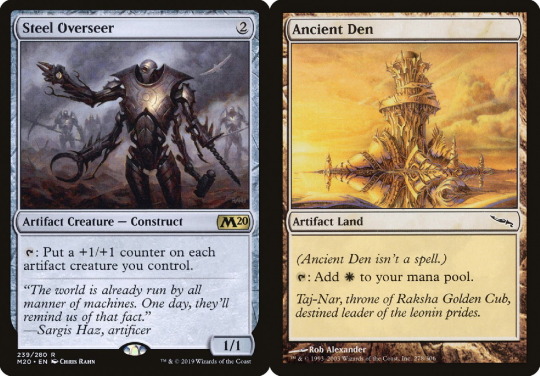
Artifacts can also come on the form of Equipment, which will give an effect when equipped to a creature. This often comes in the form of a buff to its power and toughness, but can also include adding keywords and other cool abilities. You’ll need to equip it by paying a cost, and can pass equipment around between any of your creatures. This can result in some funny mental images, such as a cat wearing a suit of armor and wielding three swords!

Enchantments are similar to artifacts in that they sit on the battlefield and have an effect, but they will have color. Also, Green and White excel at “cleansing” both by destroying them, but Red is only good at blowing up artifacts - after all, an ogre with a mace can smash a rock, but not a mystical spell.
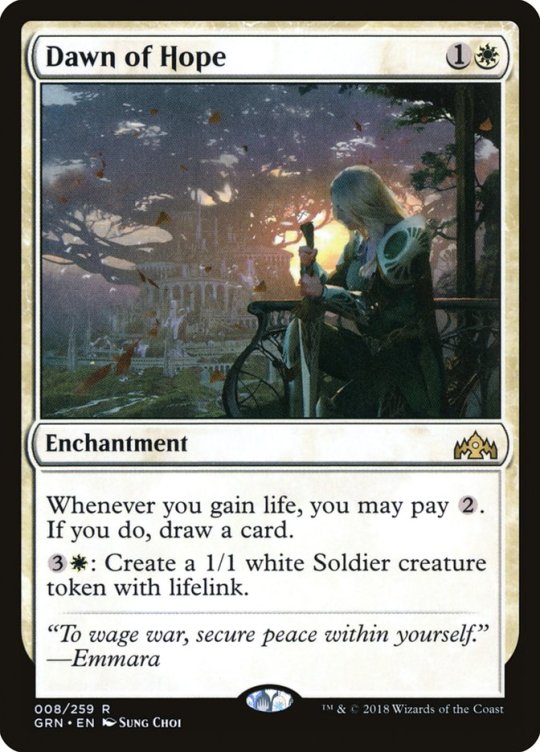
Some enchantments have the subtype Aura. This means you cast them targeting a specific permanent, and they will enter the battlefield attached to that permanent like a piece of Equipment. These, however, can’t be moved around, and will fall off and go to the graveyard if the thing they enchant ever leaves the battlefield. Auras will often buff creatures, but can also subdue permanents or boost a land’s mana production.

Planeswalkers are the newest and arguably the most powerful of the permanents. They represent the primary characters of MTG lore, beings who have incredible magical prowess and can teleport from plane to plane. They are (as of yet) all legendary, and thus you can only have one of each at a time on the battlefield.

They look pretty weird, don’t they? Instead of a power and toughness, they have a loyalty in the bottom right. Each planeswalker will enter the battlefield with that many loyalty counters on it. You can activate one of its abilities on each of your turns by adding or subtracting the indicated loyalty. Once a planeswalker is at zero, it dies and goes to the graveyard (or rather, gets fed up with your mishandling and teleports away, as per loyalty flavor). Planeswalkers can also be killed by spells that specifically target them, when they’re dealt damage, or when they’re attacked by creatures. Their last ability is often incredibly powerful, and is called an “ultimate”. Newer planeswalkers sometimes also have static abilities.
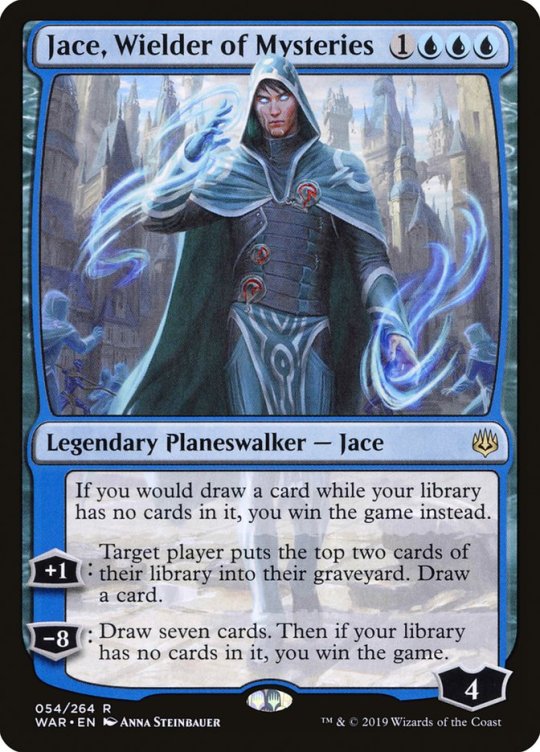
Planeswalkers are not creatures, and can’t attack or block. That being said, there are some planeswalkers that can turn into creatures.
Permanents are very useful, as they stick around and provide value turn after turn. Many strategies revolve around certain tribes, or using artifacts. Creatures are the main way to get damage through to your opponent to win the game. And planeswalkers have powerful abilities, requiring an answer from your opponent to stay in the game.
5. Spells
As stated above, all nonland cards are technically spells when cast, but here we will talk specifically about Instants and Sorceries. We will also define timing, as instant- and sorcery- speed is something we will discuss often when looking at casting spells, activating abilities, and using the stack.
Sorceries are your basic single-use card. Pay their cost, they’ll resolve, and you’ll get their effect once before they go to the graveyard.

Something I haven’t brought up yet is when you can play cards. We’ll go over the turn structure more in depth, but for now, know there’s a beginning step, a main phase, a combat phase, and a second main phase. You can play any of the previously mentioned cards, including sorceries, and activate planeswalker abilities, whenever it’s your main phase and the stack is empty.
The Stack: Whenever you cast a spell or activate a non-mana ability, or a triggered ability triggers, it will go on the stack. Things on the stack resolve last-in, first-out.
Instants are just like sorceries, but you can cast them at any time you have priority. This means they can go on the stack above other spells, which allows them to interact with other spells. Activated abilities can also be activated whenever, except for planeswalker abilities and those which specify otherwise.
Priority: When you have priority, you will have an opportunity to cast spells, play lands, and activate abilities. Everyone gets priority every phase, and it starts with the active player (whoever’s turn it is) and is passed around in turn order.
Whenever something goes on the stack, priority is passed around as well. Once each player has passed priority, it resolves and priority is passed once again for the next thing.
You can hold priority to cast multiple spells in a row.
Here’s a quick example to see how spells, abilities, and priority all interact on the stack:
Johnny and Timmy are playing each other, and it’s Timmy’s main phase. Johnny has a 0/2 Incubation Druid.
Timmy plays a Bala Ged Scorpion, which goes on the stack. Priority is passed around and it resolves. Its triggered ability goes on the stack, and Timmy targets Johnny’s Incubation Druid, since its power is 0, less than 1.
Since the ability is on the stack, Timmy gets priority and passes it to Johnny. In response, Johnny casts Burst of Strength, maintains priority, and casts a second Burst of Strength. Now priority passes between them for both, and they both resolve. Incubation Druid is now a 2/4.
Priority passes for Bala Ged Scorpion’s ability, but since the Incubation Druid now has more than 1 power, the ability does nothing and fizzles.
Fizzle: A spell whose target is no longer legal does nothing when it resolves. This is colloquially called fizzling.
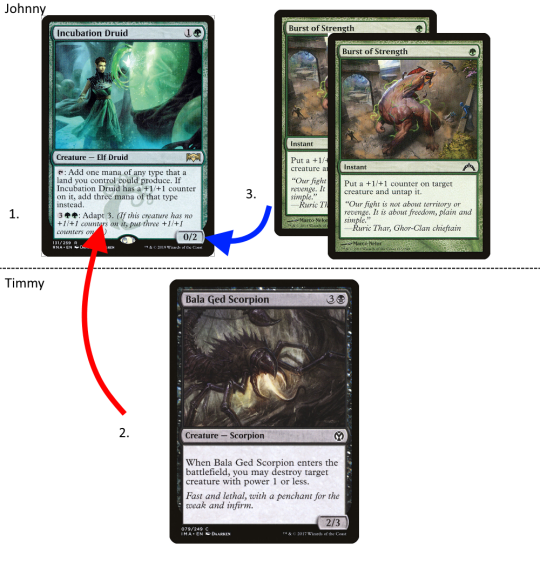
Assuming he had the mana for it, Johnny could also have activated Incubation Druid’s Adapt ability in response to the Bala Ged Scorpion, making it a 3/5 and also letting it survive.
There are lots of cool things you can do with the stack, such as making slick plays to foil your opponents’ spells or to copy big spells for massive value.
Some permanent cards have Flash. This is a keyword ability that lets you play the card as if it was an instant. Teferi, Mage of Zhalfir is the quintessential Flash card, as it also gives your other creatures flash and prevents your opponents from playing at instant speed.

6. Where are We?
I’ve been throwing around terms such as Graveyard and Battlefield, so what exactly do these mean? Well, these are all zones. We’ve already looked at one zone - Exile. The Stack is also a zone.
A zone is a place where cards can exist. They may have abilities that work while in that zone, most often on the battlefield. Public zones are where all the cards are known. This includes the Battlefield, the Graveyard, and Exile.
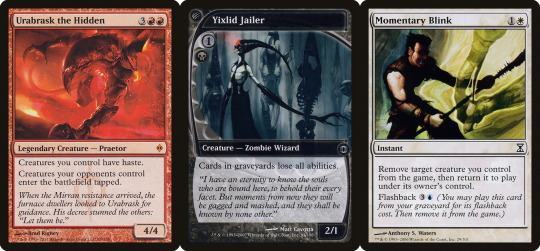
Urabrask’s ability only works while he’s on the battlefield, and only creatures you control on the battlefield would get haste - after all, those are the only ones who can use it, anyways. Yixlid Jailer takes away abilities from cards in graveyards, so Momentary Blink would not have Flashback while it’s there. Momentary Blink also exiles a creature (using the old wording of “removed from the game”) and brings it back, known as flickering.

Private zones are anywhere where cards are not public information. This includes your hand and your library. Thoughtseize, and other similar hand disruption spells, let you take a peek at what your opponent has. Loads of cards like Armillary Sphere let you search your library for cards. Others may reveal the top card of your library, or let you look at the top few.
It’s also possible to have “hidden” cards in public zones. Willbender feature the Morph mechanic, which lets you cast it face-down as a 2/2 creature. This means your opponent won’t know what it is until you turn it face up, but you will. Other effects might put cards face-down in exile, where you could cast them.
Whenever a card changes zones, it becomes a new “object”. That means all counters, equipment, and auras fall off, and it is no longer being targeted by anything that was targeting it before. A classic use of this rule is flickering a creature being targeted by a kill spell - even though it comes back to the battlefield, it is a new object and is thus no longer being targeted by the kill spell. The spell will fizzle and your creature will be safe.
7. Starting the Game
Ok. So you’ve got a basic understanding of all the cards and the different locations. How do you get started actually playing?
There are lots of ways to play the game, but I’ll start out with the most common: a 1v1, best of 3 duel. This will also get a little bit into deckbuilding, but there’s a lot more on that later.
Most 1v1 decks will be 60 cards. In fact, this is a lower limit, and you can have as many cards as you want, but it’s convention to stay at 60 cards to maintain consistency. In a best of 3 match, you will also have a sideboard - 15 or less cards that may target specific strategies such as graveyard decks or artifact decks. After your first game and seeing what your opponent is playing, you’ll be able to switch out cards in your deck for the right silver bullets for games 2 and 3.

Common sideboard cards against Burn, graveyard, and artifact strategies.
If you’re playing a casual game with a friend, feel free to omit the sideboard, but it’s a staple part of competitive play and is a fun way to personalize decks in strictly defined metagames.
Now that you’ve got a deck (and presumably, a friend with a deck as well) shuffle up. Cut your opponent’s deck by putting the top half on the bottom (a customary ritual to prevent cheating) and let them cut yours. Figure out who’s going first by rolling some dice (whoever wins gets to choose, but generally going first is preferred), and draw seven cards.
You may not like your hand for several reasons. Maybe you have too many lands, or none at all. Your lands might all produce the same color of mana instead of all the colors you need, or you might have only highly-costed spells and nothing to do on your early turns.
No problem, just shuffle it back in and draw seven more. This is called mulliganing. You can do this as many times as you want, but don’t be too hasty, because once you find a hand you like, you’ll need to put one card from your hand on the bottom of your library for each time you mulliganed.
Now it’s time for your first turn. But before we really get playing, let’s look at the structure of a turn.
8. Phases of a Turn

credit to u/paper_alien
From this fancy diagram, we can see that your turn is broken down into roughly three different parts. I’ll be including examples of cards that interact with each phase. First is the beginning phase.
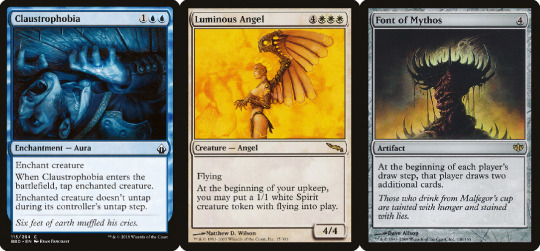
Your untap step is right at the start, when all your permanents untap. Simply turn them right-side up. Claustrophobia would prevent one of your opponents’ creatures from untapping, rendering it useless as an attacker and blocker, as well as preventing its tap abilities from being used. No player gains priority during the untap step, and play immediately proceeds to the upkeep step.
Normally, nothing happens here, unless an ability triggers. For example, the Luminous Angel gives you a 1/1 token on your upkeep. Players will get priority, so you’ll have a chance to cast instants or activate abilities as well.
After that is the draw step. You immediately draw a card, and abilities like that of Font of Mythos will trigger. Again, priority passes around. Once you’ve finished with the draw step, move on to your main phase.
Side note: Normally, players will typically condense these three steps into one (untapping and drawing), because it’s rare that you do play something here, but the steps are distinct for those cases in which you do need to take an action.

As mentioned above, your main phases are the only times you can play lands and non-instant spells, as well as activate planeswalker abilities. They sandwich your combat phase. It’s uncommon for cards to trigger during your main phases, but the two above are prime examples of such cards. Many activated abilities will also have an explicitly written restriction to only use them during your main phases.

The combat phase is the most complex, as it is really made up of five to six distinct subphases. First, you declare that you are going to move to combat. This will trigger cards like Hazoret’s Favor, and will give your opponents an opportunity to subdue your creatures before they can attack but after you have a chance to cast relevant non-instant cards.
Once priority is passed around, you move to the Declare Attackers step. Here, you will tap each creature you want to have attack, meaning you can only attack with untapped creatures, and declare the player or planeswalker it will be attacking. Creatures do not attack other creatures (this isn’t Hearthstone), and instead your opponent will have a chance to block your creatures with their own.
This happens after priority is passed around and you move to the Declare Blockers step. Your opponent will choose which of their untapped creatures they want to block your attacking creatures. Each creature can block up to one other creature, but any number of creatures can block one creature.
Next is the Damage step. Here, each unblocked creature will deal damage to the player or planeswalker it’s attacking, and each blocked or blocking creature will deal damage equal to its power to the creature(s) it’s been pitted against. If one of your creatures is being blocked by multiple, you need to divide its power among them. For example, a 3/3 being blocked by two 2/1′s must deal 1 damage to one and 2 damage to another. All creatures who have been dealt more damage than their toughness die and are put into the graveyard.
The theoretical sixth step actually occurs before the Damage step - the First/Double Strike step. If any creatures with first strike or double strike are involved in the combat, this step will be created and those creatures will have an opportunity to deal damage before other creatures. For example, if a 5/1 with first strike is blocked by a 3/3, the 5/1 will deal 5 damage to the 3/3 before it has a chance to fight back, and the 3/3 dies. Double strike means the creature deals its damage twice - during this phase and the regular combat phase.
Finally is the End of Combat step. Similarly to the Beginning of Combat step, this is mostly a formality, but some cards do trigger here (such as the Wall of Cinders), and priority is passed around.
Notice that you also get priority after every one of these phases, meaning you have tons of control over what happens. This allows you to play combat tricks. For example, say you attack with a 4/4 and your opponent has a 4/2. They might think you just want to trade creatures (meaning both die) and blocks your attacker. Before damage, you have a chance to play Giant Growth, pumping your creature out of range of your opponent’s creature, so yours survives.

This is also a great time to cover the keyword abilities I’ve been bringing up throughout, as many of them concern combat. Many of them are fairly self-explanatory, and are not exclusive to creatures.
Deathtouch: Whenever this creature deals damage to another creature, that creature dies.
Defender: This creature can’t attack. Often seen on Walls.
First Strike/Double Strike: As mentioned above, these let the creature deal damage before other creatures. Double Strike means it deals damage twice, once in the first strike damage phase and once in the regular phase.
Flash: You can play this card at instant speed. Can appear on any permanent card.
Flying: This creature can’t be blocked except by other fliers and creatures with Reach.
Haste: This creature isn’t affected by summoning sickness.
Hexproof: This can’t be targeted by your opponents’ spells and abilities. This doesn’t prevent it from being affected by “choose” or “all” effects.
Indestructible: This can’t be destroyed by damage or effects that say “destroy”. It can still be sacrificed, exiled, or given -X/-X to reduce its toughness to 0.
Lifelink: Whenever this deals damage, you gain that much life.
Reach: Can block creatures with flying.
Shroud: Like Hexproof, but also prevents you from targeting it (for example, with a pump spell or equipment).
Trample: Excess combat damage can be dealt to your opponent. However, you still need to deal lethal damage to any blockers. For example, a 5/5 with trample being blocked by a 2/3 must deal at least 3 damage to the 2/3 so that you can deal 2 damage to your opponent.
Vigilance: This creature doesn’t need to tap when attacking.
Menace: This creature must be blocked by at least two creatures.
There are many, many more keyword abilities, but these are the most common - the rest you will come across as you explore the different sets and planes.

After your second main phase comes the end step. In reality, you’ll care more about your opponent’s end step, because it is the optimal time to play removal, card draw, or other useful instants because it will give your opponent the least amount of time to react before your next turn. However, once priority is passed during your end step, check if you have more than seven cards in your hand - the maximum hand size. if you do, the cleanup step is created. Here, you must discard down to seven cards, and there will be another chance for priority after that. Seven is the default maximum hand size, but there are many cards that let you play around with that.
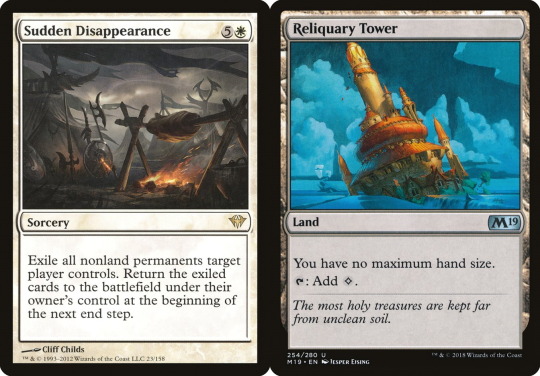
So now you’ve got your deck, you’ve mulliganed as you need, you’ve played an Island. I see you preparing to cast that Opt - but wait! Casting a spell is quite a bit more complex than it first seems, so let’s go over that now.
9. Casting Spells and Activating Abilities
All this time, I’ve been talking about casting and activating without really explaining exactly what that means, so now let’s make sure you know what that means. There is a lot of nuance to properly casting a spell, but once you understand it, you can ignore all the decorum in most cases. However, it’s still important to know exactly what happens to prevent common misunderstandings, and because Magic is full of strange cards that love to bend the rules; you will doubtless find fun corner cases.
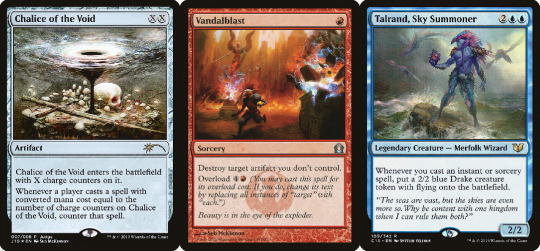

The steps to casting a spell and activating an ability are identical except the first, so I will be going over them together, referring to casting a spell.
Declare you are going to be casting the spell by putting it from where it is (generally, your hand) onto the stack. An ability will be put onto the stack as an arbitrary object.
Declare all the additional and alternative costs you wish to pay (for example, Vandalblast’s Overload cost), the mode of the card for split cards (such as Assure // Assemble) and double-faced cards (such as Alrund, who is also a bird on his other side!), and define the value of X (such as for Chalice of the Void), which you can pay for in mana of any color.
Choose the targets of your spell. You must have a legal target for each time the word “target” appears on the card (this is when effects such as “When this becomes the target of a spell” are triggered and go on the stack, to be sorted out and resolved later).
Now determine how much you need to pay. This includes cost reductions and additional costs, such as for Torgaar, as well as taxing effects (i.e., “noncreature spells cost {1} more to cast).
Activate mana abilities, such as those from your lands and mana rocks, and pay all costs as required. This means, for example, that you can tap a creature that produces mana and sacrifice it to pay for Torgaar.
Congratulations! Your spell or ability is now on the stack. Abilities that trigger while you are casting your spell, such as Talrand’s, will be on the stack above it and will thus resolve first. We covered fizzling before, but to clarify, a spell will fizzle only if all its targets are no longer legal, either through dying, or gaining Hexproof, or some other means. This means you get no part of its effects. If it has multiple targets, and only some become illegal, the card resolves as normal.
Like I said, you really don’t need to understand all of this in depth, but it helps clarify the occasional odd rules interaction.
10. Abilities
There are four types of abilities that you might find on cards. The one we’ve just covered extensively was activated abilities, which further come in two forms.
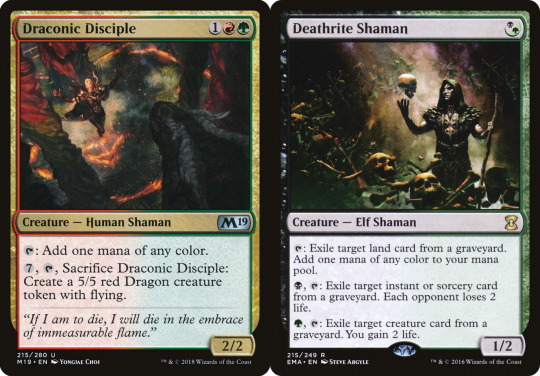
Draconic Disciple handily features both: a mana ability, and a normal activated ability. Notice that all activated abilities use the syntax “Cost X, Cost Y: Ability.” As we covered last chapter, you need to use mana abilities before paying costs when activating an ability, so you couldn’t tap Draconic Shaman for mana for his own ability as well as tap him to summon the dragon.
The main distinction for mana abilities is that they don’t use the stack, resolve instantly, and can be used while casting spells. An activated ability is considered a mana ability if and only if all it does is create mana. That means that Deathrite Shaman’s first ability is not a mana ability, because it exiles a land in addition to creating a mana.
The three other types of abilities are triggered abilities, passive abilities, and replacement effects.

Vanquisher’s Banner features a passive ability by giving all your creatures of a certain creature type +1/+1. It’s pretty straightforward: a static ability simply applies as long as the permanent which has it is on the battlefield. There are nuances in “layering”, but this is already far more complex than you’ll need to know for the majority of games. Feel free to read that article, though.
Vanquisher’s Banner’s third ability is a triggered ability - an ability that goes on the stack when something happens. This could be casting a spell, a creature entering the battlefield, or drawing a card - or just about anything. These are generally in the form “When” or “Whenever”, and should not be confused with replacement effects.
Replacement effects, like the one seen on Teferi’s Ageless Insight, come in the form “If... would... instead”. They are similar to triggered abilities in that they occur in response to something happening, but they don’t use the stack. Instead, think of them as modifiers to abilities. For example, if Teferi’s Ageless Insight was formatted like a triggered ability, drawing you a card each time you drew a card, you’d be stuck in an endless loop of drawing. Instead, replacement effects only apply once to each thing they modify.

There are many ways that abilities might manifest themselves, and they don’t always need to be on the battlefield. Bridge From Below’s wall of text works when it’s in the graveyard. Skyscribing’s ability only works from your hand, and is keyworded by Forecast, which only appeared in the original Ravnica set.
The best way to experience all the different interesting abilities and cards is just by playing and expanding your collection. Enjoy playing around and learning more about the game.
This is just about all you need to know to understand the game itself. However, Magic cards just love bending the rules, so you’ll always be encountering interesting rules interactions that will teach you more about the game as you play.
11. Formats
Here is where the fun really begins. Choosing a format is like choosing a social media platform: it comes with its own drama, flavor, speed, and player personalities. All formats use 60 card decks with 15 card sideboards, and start at 20 life, except Brawl and Commander. Each format has its own banlist, so make sure you check that before building just any deck. However, feel free to totally disregard all formats and just build whatever deck you want to have fun with friends!
Here are the most popular formats:
Standard: Probably the most popular 1v1 format, Standard uses cards from the last few sets, and constantly rotates. Deck prices can range from under 100$ to over 500$ when certain powerful cards are in rotation, but when a card rotates out, it can lose its value if it isn’t played in older formats. It can be competitive, but also lets you play with fun new cards in a weaker environment.
Pioneer: The newest official format, Pioneer uses cards dating back to the set Return to Ravnica. It has the same fresh feel as Standard, but doesn’t rotate and is closer in power level to Modern.
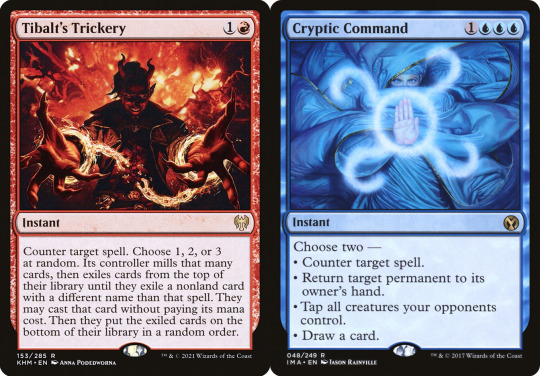
Modern: This format uses cards from the newest set all the way back to Eighth Edition from 2003. Decidedly more powerful than Standard, and expensive as well. Competitive decks can range from 200-1000$, but the vast size of the card pool means you can find budget builds and underdog decks to tinker with.
Legacy: You can use any card in the history of Magic, except those from the Banlist. The power level is incredibly high, yet the stereotype of 2-turn games is not as true as one might think. Because of the original dual lands, decks are often over 1000$, but mono-colored decks such as Burn can be brought down to 200$. Definitely not for the faint of heart.

Vintage: Like legacy, all cards are at your disposal, and this time, instead of a banlist, you have a restricted list, meaning you are limited to 1 copy of certain cards. A single copy of Black Lotus can be tens of thousands of dollars, and is a staple alongside the rest of the Power Nine. Very few play it because of the price tag, but it lets you tap into the true power of the oldest Magic cards.
Commander (AKA EDH): Play with any card, like Legacy, but with the distinct Commander banlist. The deckbuilding process here is very different: Pick a legendary creature you like, and pick 99 more cards that are of the same color(s) as your commander. This is a singleton format, meaning you can only have one of each card except for basic lands. Commander is also a multiplayer format, played in pods of 3-6; most often 4. Your commander starts in the Command Zone, where you can cast it. Each time it dies, it goes back to the Command Zone, where you can replay it for an additional 2 mana each time. The multiplayer nature, 40 starting life total, and high variance make Commander incredibly casual, much more a social event than a game. Have fun casting huge spells, playing pet cards, and embodying your commander. That being said, there’s a competitive scene in EDH, known as cEDH.
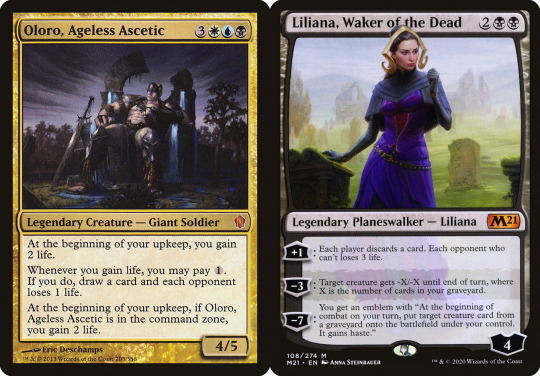
Brawl: Ah, Brawl. Commander’s younger, forgotten brother. It’s a cross between Commander and Standard, in which you have a commander (in this case, it can also be a planeswalker) and must have singleton copies of cards. Like Standard, you can only use cards from the last few sets, your deck is only 60 cards (no sideboard, though), and games are 1v1. You start with 25 life. Almost nobody plays this in person, but it’s very fun on MTG Arena.
12. Where to Play
Assuming you don’t have a group of friends ready to accept you into their playgroup, finding people to play with can be hard. First, I’d recommend checking Wizards of the Coast’s official Store Locator to find local game stores that might be hosting events and selling cards. If you go to their websites, they’ll often have calendars listing events by date, format, price, and prize. Explore and find one you like. MTG players are generally friendly, and will be willing to accept you into their playgroup, teach you about the game, and maybe even let you borrow a deck!
If you don’t feel like playing in person, there are several online options.
Magic Online (AKA MTGO or MODO) is the primary official way to play. Pay 10$ for an account, and you can buy, sell, and trade cards as if they were real. No really - Magic cards are almost like stocks, and MTGO cards are basically digital versions of Magic cards, so their price will generally mirror their real world counterparts, albeit at a lower price.
Magic Arena (MTGA) is the newest official online game. It only has cards from recent sets, back to Kaladesh, as well as a few odd cards hand-picked for Historic play (a format specific to the game that uses all cards available). Because of the smaller card pool, MTGA is limited to Standard, Brawl, and Historic as the primary game modes. However, it is free to play and your collection can’t be traded, so you collect cards somewhat like Hearthstone.
There are also a few unofficial programs, including Untap.in, XMage, and Cockatrice, which are free and give you access to the full range of cards for testing new decks before you buy them in paper.
Make sure you keep track of MagicFests, official conventions hosted both around the world and online, to meet tons of new people and play in competitive events.
Ultimately, though, many people choose to play at home around the kitchen table with friends and family. Play wherever and however you feel most comfortable; after all, Magic’s best aspect is self-expression.
13. Accessories

Credit: Tolarian Community College
If you’ve visited a local game store by now, you may have noticed that they sell way more than just cards. There are a myriad of accessories you can use to personalize your game and protect your cards.
Dice: from D4′s to D20′s, you can find these in countless colors and styles. Have fun picking your favorite and use them to keep track of life totals, counters, tokens, and more.
Sleeves: These can come in many different colors and designs, but vary wildly in quality. Pick the ones that feel right for you. These will help you shuffle your deck with ease and prevent your cards from getting damaged. Inner and outer sleeves provide additional protection for your most valuable and prized decks.
Deckboxes: Again, tons of variation. The right deckbox for you will depend on how many cards you want to fit in it, if you want space for dice, the design, and much more.
Playmats: These provide a sleek surface for you to easily pick up, tap, and move your cards around. Pick ones with your favorite Magic art, or order one with your own.
Trade Binders: Once you’ve built up a collection, you might have a few valuable cards you want to show off. Put them in a trade binder, and approach people to find other neat cards you might need.
Tolarian Community College on Youtube provides the best reviews of popular accessories, rating and testing them thoroughly. He also dishes out incredible commentary on new sets and the state of the game. Probably the most popular MTG Youtuber out there.
14. Further Resources
You’ve made it this far, but there’s still so much to explore! Here, I’ll be listing plenty of websites that are excellent resources to expand your understanding of the game.
The official rules: Quite dry, but this is where to go if you ever find a confusing interaction.
Tolarian Community College: I just discussed him, but I must reiterate how awesome his channel is.
Scryfall: A powerful search engine for all the Magic cards you might be looking for. What I’ve been using for card images this whole time. WOTC’s official Gatherer pales in comparison.
TCGPlayer: My favorite way to order cards online, but alternatives include Card Kingdom, StarCityGames, and ChannelFireball.
MTGGoldfish: An excellent all-round resource for keeping track of metagames, card prices, and interesting articles and gameplay. You can also use it to find, build, and share decks and see their prices.
EDHREC: This site conglomerates EDH decks from around the internet to give you a condensed list of the best cards by commander. A must-have resource when building new commander decks.
Last but not least, the best way to learn to play Magic is to watch others. I started out by watching gameplay from Grand Prix’s and other competitions on Youtube. Even though I barely knew what the cards were, I quickly picked up the most popular ones, learned common play patterns, and more. You don’t need to be a pro to learn from them.
15. Have Fun!
Yeah, it’s cheesy, but as I’ve reiterated, Magic is a game of self-expression. With thousands of cards to pick from, plenty of formats, styles, and accessories, customize your play experience as much as you want and be comfortable with that. Meet new people, participate in trading, and play in local events. Magic is what you make of it, so make it the best it can be.
30 notes
·
View notes
Video
youtube
This week on Great Albums: a Great Album that your average rock critic would actually agree with me about! Find out how Kate Bush got her groove back with her fifth LP, Hounds of Love, and whether she ever came down from that hill. Full transcript below the break!
Welcome to Passionate Reply, and welcome to Great Albums! Ever since I first conceived the idea of Great Albums, I’ve always intended it to reflect nothing other than my own personal “canon”--not necessarily a list of albums that were influential, successful, or acclaimed by anybody’s standards but my own. But in this installment, I’m making a somewhat uncharacteristic move, and diving into an album that really doesn’t need me to advocate for it: Hounds of Love, by Kate Bush, often considered Bush’s greatest masterpiece--if not one of the greatest albums of all time.
Released in 1985, Hounds of Love was Bush’s fifth studio LP. Her career had started off surprisingly strong in 1977, with the release of her debut single “Wuthering Heights,” written when Bush was only 19 years old. With a high-concept theme, based around the titular novel by Emily Brontë, it would set the template for much of Bush’s subsequent career: irreverently eccentric, high-concept art-pop with the intensely personal passion of a singular singer-songwriter. But just how much patience for that sort of thing does the general public have, beyond letting the occasional “Wuthering Heights” through as a sort of novelty hit? Bush’s subsequent work in the early 1980s met with inconsistent reception, with her fourth LP, 1982’s The Dreaming, marking a particularly low point. The first album that Bush produced all by herself, The Dreaming took even more radical creative liberties, pushing her sound into increasingly experimental territory.
Music: “Get Out Of My House”
Following the fairly cold reception of The Dreaming, Bush took several years to produce her next album, but it would prove to be the one that redeemed her career, and arguably turned her into a bigger star than ever before. Hounds of Love managed to stay true to the core principles of the Bush aesthetic: moody and introspective, full of rich and complex narratives, as well as musical risk-taking. But it honed and refined that sound into something that was also remarkably pop.
Music: “Running Up That Hill”
“Running Up That Hill” was one of the biggest hits of Bush’s career, and arguably dethroned even “Wuthering Heights” as her signature song. I think the secret to its success is its ability to balance Bush’s experimental impulses with an intuitive, deep-felt emotional quality that makes her best work resonant in an accessible way. On paper, “Running Up That Hill” is as high-concept as anything else in Bush’s catalogue--a song about making a deal with God to swap sexes with your lover, and feel what life is like in another body? But at the same time, the song has an ability to “work” even if you don’t know all of that. Who hasn’t longed for a way to bargain with supernatural forces, for a chance at the impossible? There’s a certain applicability to its themes, which I think is a chief reason why it’s inspired so many covers and reimaginings over the years. But even when one listens to the original, the stately washes of digital synthesiser and the powerful conviction that propels Bush’s vocals make it easy to sympathize with. It feels grounded and physical, rooted in the most carnal aspect of the human body. Positioned as the opening track of the album, “Running Up That Hill” feels like an obvious lead single--in the best way possible. But it’s worth noting that not everything on the album is quite so radio-friendly.
Music: “Cloudbusting”
Perhaps one of Bush’s most compelling narratives, “Cloudbusting” is also, ostensibly, fairly high-concept, portraying a heavily fictionalized episode from the life of Wilhelm Reich. A controversial figure both in life and legacy, Reich is best remembered for his work in psychology, heavily influenced by the spectre of Sigmund Freud. But “Cloudbusting” focuses on his later-life fascination with the physical sciences, and his belief that a mystical energy called “orgone” was responsible for both human emotional woes as well as disturbances in the Earth’s atmosphere. Reich attempted to develop a machine that could manipulate this energy, and hence achieve the longtime dream of technological weather control, but there’s no evidence his “cloudbuster” really worked, or that there’s any such thing as “orgone.” But Bush’s “Cloudbusting,” and its accompanying music video, portray Reich as a tragic hero, silenced by government authorities who sought to destroy what they couldn’t understand, conflating his work with cloudbusters with his censure by the FDA for his questionable medical devices.
The song was inspired chiefly by the memoirs of Wilhelm Reich’s son, Peter, with Bush explicitly portraying Peter’s naive childhood perspective on his father, and that does allow for some substantial nuance here...but at some point we have to ask ourselves what responsibility an artist has to the truth. “Cloudbusting” is the musical equivalent of a film that’s “based on a true story,” and I see no reason why music can’t be just as capable of spreading misinformation as the Oscar-bait biopics of Hollywood. Just how accurate, or how beautiful, does a work of art need to be, for us to allow a bit of playing loose with the facts for the sake of a great story?
Setting aside these quandaries presented by its subject matter, “Cloudbusting” undoubtedly delivers musically. Across its sprawling runtime, it develops and earns a sense of grandeur, building from its infectious percussion and cresting with Bush’s fragile, but assertive prayer: “I just know that something good is going to happen.” If you listen closely to the percussion tracks on the album, you’ll notice that there’s no cymbal or high-hat utilized anywhere, which helps give the album its particular hazy, meandering ambiance.
That effect is perhaps even more pronounced on the second side of the album. Hounds of Love is divided quite sharply into two sides. The first side, also sub-titled Hounds of Love, opens with “Running Up That Hill,” and finishes with “Cloudbusting,” which serves as something of a bridge between the two, combining a singable hook and a pop-like verse-chorus structure with a taste for more visionary narrative. While the first side is home to all four of the album’s singles, the second side, sub-titled The Ninth Wave, strays much further away from the standard expectations of pop.
Music: “Under Ice”
Going by the tracklisting, there are seven tracks that make up *The Ninth Wave,* though their smooth transitions and willful defiance of verse/chorus structure create a seamless oratorio or song cycle feel, not unlike many of the great “album sides” of the prog tradition. The Ninth Wave also departs from the feel of the first side in its instrumentation. While the Hounds of Love side has its fair share of exotic instruments, such as a balalaika on “Running Up That Hill” and a didgeridoo on “Cloudbusting,” The Ninth Wave is more richly baroque, with elements like that jarring violin on “Under Ice.” As it progresses, the breadth of timbres increases, climaxing in the Celtic-inspired “Jig of Life.”
Music: “Jig of Life”
The explosion of folkish, backward-looking sounds of “Jig of Life” and “Hello World,” with their fiddles, whistles, and full choir, represent its protagonist’s return to the realm of the living, after the trauma represented by earlier tracks like “Under Ice.” The abstract, though affecting, narrative presented by The Ninth Wave seems to be a tale of death and rebirth, with a narrator who drowns themselves, only to be reborn--whether literally revived from a failed suicide attempt, or metaphysically reincarnated after a passage through the realm of the dead.
Much more has been written about the themes of *The Ninth Wave* than I’m getting into here, but suffice it to say that many people consider it the relative highlight of the album. But I think it’s worth questioning that a little bit, and taking the time to look at Hounds of Love a bit more holistically. Just because the first side is a bit less overtly experimental doesn’t mean it doesn’t have just as much to offer, artistically, or that it isn’t a part of what makes this album truly great. At the end of the day, I think we can probably agree that far fewer people would have ever heard The Ninth Wave if it weren’t for those more accessible singles on side one, moving copies of the record and adding to Bush’s widespread acclaim. Without “Running Up That Hill,” Hounds of Love might have gone down in history as a fairly niche cult classic like The Dreaming, instead of the era-defining album that it got to become.
On the cover of Hounds of Love, we see an image of Bush reclining and embracing two dogs--who were, in fact, her own pets. The image’s saturation in purplish pink and Bush’s perhaps sultry expression combine to create an impression of traditional femininity, which resonates with the album’s themes of gender and sensuality. Framed in by large white borders, we might read the composition of the cover as evocative of a personal locket or memento, a sort of furtive glimpse into Bush’s more private or intimate essence, fitting for the introspective and emotional focus of much of the music. This “framing” is perhaps also evocative of the idea of the domestic sphere of life--and hence, again, of femininity.
While the title track of the album portrays the “hounds of love” as figures of menace, who are said to “chase” after its narrator, the submissive and comfortable-looking canines portrayed in the cover art seem like a foil to that idea. In the history of European art, dogs are often used as symbols of fidelity, particularly in the context of romance. Titian’s Venus of Urbino, painted in the 1530s, is often considered the progenitor of the Western “nude” as an archetype. Alongside the titular goddess, paragon of eroticism and the feminine, the painter has also included a lapdog, peacefully dozing beside her. It’s tempting to see the composition of the cover of Hounds of Love as doing something similar, invoking confident sensuality alongside a symbol of faithfulness to portray the essence of idealized love.
After the release of Hounds of Love, Bush would once again take several years to produce her next LP, 1989’s The Sensual World. More closely related to The Ninth Wave than the A-side of Hounds of Love, it was nonetheless another commercial and mainstream success for the artist.
Music: “The Sensual World”
From the mid-90s to the mid-00s, Bush took an extended hiatus from music, focusing instead on her family and her personal life. Despite uncertainty surrounding the future of her career, she would eventually return to the public spotlight in the 21st Century, and remains active, if somewhat intermittently, to the present day. At this point, it’s safe to say that Bush has a fairly enviable position, having lived long enough to become a cultural institution, and able to bask in the cult following her unmistakable and distinctive work has earned her. For as much as I’ve praised the more commercial side of Hounds of Love in this piece, I still believe in the power of the truly unfettered creative soul, and I’m still happy for Bush that she’s achieved that kind of freedom.
My favourite track from either side of Hounds of Love would have to be “The Big Sky.” In the context of the album, it stands out for its rousing, triumphant crescendo of energy--a marked difference from the languid, introspective sensibility that dominates most of the material. And it manages that without bringing the cymbals back, either! Thematically, its emphasis on weather and the sky prefigures that of “Cloudbusting,” perhaps providing a more hopeful and naive vision of what weather can do, which resists being “clouded” by political drama. That’s all I have for today--as always, thank you all for listening!
Music: “The Big Sky”
14 notes
·
View notes
Text
10 Game Changer Films
Over the past century, there have been many movies that were marked with quality acting and quality story telling. Some movies are genre defining and remain memorable long after the movie is released. Some movies are perfect little 2 hour pieces of art. And beyond that, there are movies that transcend genre and change the way that movies are produced and viewed. Here is a list of ten movies the changed Hollywood cinema. There is no way to rank them in order of importance because they all shaped the way movies were made and presented at the time, so 10 are listed in order of date. Feel free to add suggestions for game changer movies in the comments. This is a list of American films and doesn’t come close to all game changers, but these 10 stick out in my head whenever I am asked for examples:
------------------------------------------------------------------
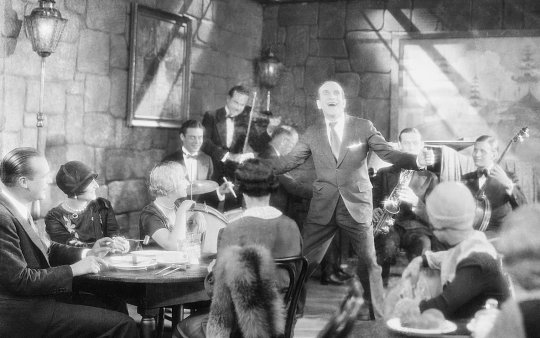
The Jazz Singer (1927):
The movie that marked the end of the silent era, this was the first feature-length motion picture with synchronized recorded music and lip-synchronous singing and speech. It is has six songs performed by Al Jolson. It is the story of a Jewish boy who wants to become a singer despite the traditions of his devout family. The boy is caught singing and decides to run away from home, change his name, and become a famous jazz singer. He tries to disguise himself while performing at one point and makes the unfortunate choice of putting on black face. It is kind of hard to watch, but the advent of the “talkie” changed the way audiences enjoyed movies from that point on.

Steamboat Willie (1928):
This was the first Disney cartoon with synchronized sound with a fully post-produced soundtrack. It is also considered to be the debut of Mickey Mouse. The layered drawings have a realistic feel and are impressive today despite being almost 100 years old. Also, nothing beats that iconic opening sound of the film in which you can hear the film reel behind the sound of the lead character whistling. Animation became a genre at that moment and has done nothing but grow and improve, but this seems like the seed that started it all.
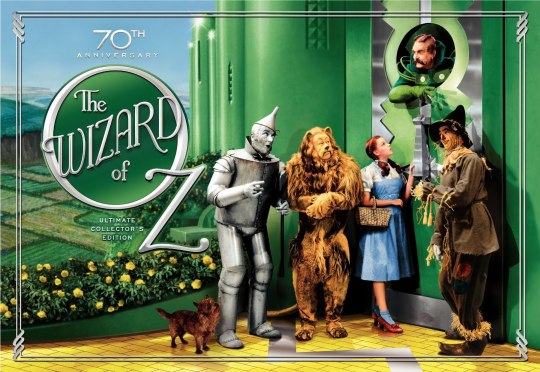
The Wizard of Oz (1939):
Generally considered to be one of the greatest films of all time, this juggernaut of a film was not considered best Best Picture nor was it even a financial success on first release. It was re-released and played on TV in 1956 and is now considered the most seen film in movie history. What really makes the film a game changer is the moment when Dorothy lands in Oz and she steps out her sepia/black & white home and walks into a world of Technicolor. Although many great black and white films where made after this film, it was a symbolic change for audience preference for color films. Kansas was so grey and bleak and the world of Oz was so bright and beautiful...it really is an unparalleled moment in film.

Citizen Kane (1941):
Considered by many to be the perfect film and the best Hollywood film of all time, this film is on the top of many “Best” lists. Director and lead actor Orson Welles used “deep focus” to make all aspects of the picture pop out at the audience. He was having difficulty creating some of the film angles to create this effect, so he would lay on the floor and even break into the stage to create the perfect shot. He also took the camera up to the stage light walkways to create others. The entire narrative was told in flashback from a group of unreliable narrators and the main character dies within the first 2 minutes of the film. The use of lighting and storytelling is an amalgamation of different techniques from around the world of film at the time, including some aspects made up on the spot. Watching the film now, it seems apparent that the bar for movies was raised 90 seconds into the film when the main character says “Rosebud.”
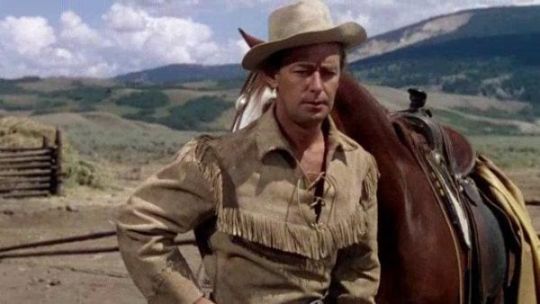
Shane (1953):
This film is not really known for being the very best acted, but it came out right when a bunch of audio and video technology improved simultaneously. The film was shot in standard ratio, but, due to the beautiful shots along the American Plains, was selected by Paramount to debut widescreen format. To get out the word, the film was played at Radio City Music Hall on a specially fitted 30ftx50ft screen. Not to let the visuals overshadow the sound, a new stereophonic soundtrack was recorded and played on an interlocking 35mm magnetic reel in the projection both. The sight of the sweeping landscapes and the echoing ring of gunshots was unlike anything that audiences had ever experienced while setting the standard for movies for years to come.

Jaws (1975):
From the opening scene with a young girl being attacked while skinny dipping in the ocean, the film caused legitimate panic amongst film goers. It also created the summer blockbuster which continues to affect how movies are released 45 years later. Spielberg became a household name and the use of the dolly zoom to represent a sudden realization became part of movie language. Along with the films simple and iconic score that made up for a constantly malfunctioning prop, this revenge story made thousands of wanna-be directors realize that it didn’t take a who lot to make an extremely successful movie. Camera trickery, good sound, and a descent plot could make any budding director into a millionaire.

Star Wars (1977):
Arguably the most successful film of all time, this story of the classic hero’s journey is epic and yet simple. There are few movies I have seen with better pacing because the time always flies by. The characters are relatable despite being robots, aliens, and wizards. The aspect of the movie that really made it was the special effects by Industrial Light and Magic. The famous “trench run” on the death star was something that was like a roller coaster on screen. How easy it was to get sucked in to the film is an influence on directors and movie production to this day.

Toy Story (1995):
This was a film that was actually the accumulation of over a decade’s worth of computer graphic technology. It is the first completely CG film and it is excellent. The film score is amazing, the graphics were far better than any audience had seen or ever expected, and it created an entire new way to manufacture a film world. This was also the first film for Pixar, which made far and away the best family films over the last quarter century.
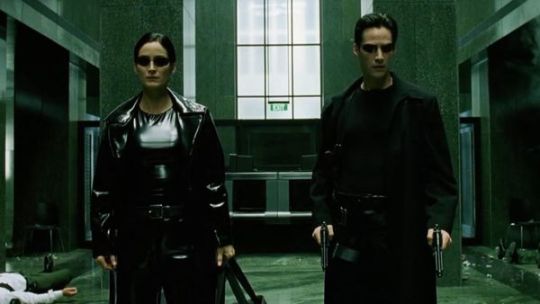
The Matrix (1999):
This film might be somewhat arguable as a game changer, but one aspect of the movie is globally known whether you have seen the movie or not: bullet time. The fight scenes and the wire work for stunts along with the speeding up and slowing down of the film was revolutionary. That moment when Neo dodges the bullets that were shot at him while the camera rotates to show how close the misses were is phenomenal. The action set pieces are frequent with loud pumping music and it influenced audience expectations for how massive a fight scene could be. The judo fight between Neo and Morpheus, the rescue of Morpheus from the agents, the subway fight, and Neo’s enlightenment are all epic fights worthy of an entire film. It was an introduction to cyber punk that kicked in the door for a mass of violent and loud sci-fi films that continue to be cool to this day.

Avatar (2009):
A movie that was 15 years in the making due to a world created completely with computer graphics that interacts seamlessly with human characters, this probably the best looking theater film ever created. The story is not so great, but the world that is created is made specifically to envelop a theater audience. It is a two hour experience like no other and needs to be seen in a full 3D theater with surround sound. It made all other films up their visual game and is the second most lucrative movie in straight dollar amount and the second most lucrative film adjusted for inflation (despite being only 10 years old).
-----------------------------------------------------------------------
This count of 10 is obviously debatable and many films are worthy of a spot on a list like this. This is a list of the 10 that amazed me and made me think that audiences would have changed their expectations of the film experience after seeing the film. If you have movies that have had this effect on you, please list them for others to enjoy.
#Avatar#the matrix#great movies#film history#top 10#star wars#jaws#toy story#shane#the wizard of oz#game changer#introvert#introverts
23 notes
·
View notes
Text
On the subject of: Micronations
(Note: not written for political purposes, only information on an interesting topic. Not intended to be taken as a serious examination of living monarchies)
While not the most shining example of modern monarchy, monarchist micronations are still an example to be thoroughly examined when considering the implications of creating new monarchies and how they are accepted in the present world.
To start, let’s examine a few living micronations and how they came to be:
Sealand (est. 1967)
The Crown Dependency of Forvik (declared independent in 2008)
Kingdom of Talossa (est. 1979)
Principality of Seborga (claim extends back to Middle Ages)
Each of these has notable claim to independence and has garnered support for their actions both online and in person. Let us begin with examining the famous Principality of Sealand:
Founded in 1967 on a WWII-era Maunsell Fort (originally built to defend against Axis ships, submarines, and aircraft), it was declared a principality by British-born national Patrick “Paddy” Bates after being occupied for two years. The principality faced invasion by British authorities (despite being in international waters) was sacked by mercenaries hired by a former associate of Bates, saw the “Crown Prince” Michael taken hostage, and eventually was given its independence. This micronation is seen as a symbol of independent thought and innovation in the face of adversity. Today, Sealand continues to operate as a monarchist state and has sports teams, sells/produces titles of nobility, passports, currency, and is active in social media. One of the first modern micronations, it has certainly been an interesting addition to British history and has stood as inspiration for later micronations. More information can be found here:
https://sealandgov.org/
The Crown Dependency of Forvik was established in 2008 on a small island within the Scottish Shetland islands. While not as “legitimate” (as much as a micronation can be) as the others listed, this principality has never had a physical population and citizenship can only be obtained through yearly payments online. On the island, though, there are the remnants of a structure that cannot conclusively be identified. It could be anything from a Pictish era fort-type building to a sheep pen. In any case, ownership is disputed between Mark King, the original owner of the island, and Stuart Hill, or “Captain Calamity”, who had shipwrecked there while attempting to sail around the British Isles. The small island was declared a Crown Dependency, making it independent of the British Crown and self-governing. This, Hill claims, has inspired Shetland secessionists and he is actively involved in their movements. According to the Wikipedia page on the Crown Dependency of Forvik (for lack of better source): “Hill cited an arrangement struck in 1469 between King Christian I of Denmark/Norway and Scotland’s King James III, whereby Christian effectively pawned the Shetland Islands to James in order to raise money for his daughter's dowry. He contended that, as the loan was never repaid and no other legal agreement ever put in place, Shetland remains in a constitutional limbo, and should properly enjoy the status of Crown Dependencies such as the Isle of Man or the Channel Islands. The validity of this was not accepted by the British government.” Now, the Crown Dependency of Forvik serves as a symbol for Shetland secessionists who strive for independence of the British Crown. More information can be found here (with additional links to other references):
https://en.wikipedia.org/wiki/Forewick_Holm
The Kingdom of Talossa (Talossa is Finnish for “within the house”) was created in 1979 in Milwaukee, Wisconsin in the bedroom of 14 year old Robert Madison. It was documented in publications such as Wired and the New York Times garnering interest in the micronation and inspiring people to obtain Talossian “citizenship”. The Kingdom of Talossa developed to the point that the nation has its own language, with an extensive vocabulary based primarily on French. Though claiming an area of only 13 km2 in Milwaukee, the small country claims a population of around 250 individuals from multiple nations that maintain their citizenship primarily online. Talossa takes pride in its culture and language, and is arguably far more developed than other micronations. While the Kingdom of Talossa has a very spread-out “populace”, it is surprisingly close-knit with online forums, occasional physical meetings, and active cabinet involvement from members. For the purposes of this list, the Kingdom of Talossa may be considered the most complex of the given micronations. Between the developed culture, artificial language, and tight community, Talossa is a unique micronation. More information can be found here:
https://talossa.com/
The Principality of Seborga is perhaps the most legitimate on this list. Founded as a micronation in 1963 by Giorgio Carbone, he claimed that Vatican records showed Seborga as never having fallen under the jurisdiction of the House of Savoy, therefore making it a continually independent nation since 954 A.D. The same year as its refoundation, the people of Seborga voted to make Carbone their monarch, styling himself as His Tremendousness Prince Giorgio I of Serboga. The position is not hereditary, and every seven years a new head of state is voted on. After the death of Giorgio I, Italian-Swiss businessman Marcello Menegatto was elected Prince of Seborga and ruled until his abdication in 2019, after which his wife became ruler of Seborga as Princess Nina Menegatto. Although Seborga claims to have been recognized as a sovereign nation by Burkina Faso, which would make it the most legitimate of the nations in this list, and has a (supposed) history of independence dating back longer than a portion of modern nations, the validity of Seborga’s claims to statehood have been speculated by some to be a ploy in the interest of attracting tourists. Even if it isn’t a true, this micronation is unique in its claims compared to others. More information can be found here:
https://www.principatodiseborga.com/pds/
Small sovereignties that claim independence and have potential to grow over time have always existed and always will. The physical borders of a nation are never set in stone. Our world is perpetually shifting politically, which means that as time marches on, countries will appear and disappear; empires will take root and eventually be ripped from their soil; small nations will spring up and fade into the annals of history. Nothing of human design is eternal, nothing is for certain. Micronations offer a unique view into the every-changing world we live in, and are shining examples of humanity’s need for independence, community, and freedom.
#monarchy#Monarchism#Monarchist#monarchies#micronation#micronations#sealand#principality of sealand#principality#forvik#crown dependency#crown dependency of forvik#talossa#kingdom of talossa#kingdom#principality of seborga#seborga#countries#history#world history
11 notes
·
View notes
Text
Some other interesting things to note in the old rogue trader 1st edition 40k book
The book itself has a fascinating structure to it because its actually frontloaded with the game rules, equipment and the like first [including a mutants table] and backloaded with the 40k setting details. Partly because unlike the modern 40k which is about playing games within the setting, the old rules seem more so geared towards creating rules to play a game of your choice. That is, well im not sure how well it would actually work the book does seem to encourage you to make shit up or even use a completely different setting like star wars instead.

some space marine chapter symbols on one of the opening pages. you can see chapter symbols for 7 of the modern big 9 of the loyalist chapters [blood angels, imperial fists, iron hands, space wolves, ultramarines, white scars] but they seem to be placed alongside the blood drinkers, flesh eaters, flesh tearers, and the... i think the rainbow warriors and silver skulls chapter symbols as well. Best guess is that they were originally suppose to be a lot more important then they ended up being. Also interesting to note but of the 7 of the big 9 here, only the iron hands symbol seems to get any major modification later on [if it is the iron hands anyways]. the early dark angels symbol has a thin in the middle fat on the end shaped sword in early versions and the space wolves symbol gets more bestial in modern versions, but the iron hands logo in modern 40k is flipped with pointier finger tips compared to here.
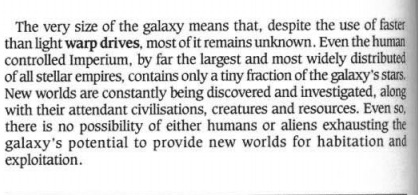
an interesting note here, since the modern 40k setting has a tendency to make the imperium seem and feel so monolithic and all encompassing on the galactic stage. Here its more so emphasized that even with the imperium being fairly large its only a blip in terms of the actual galactic scale of things. Something i wish was more carried through into modern 40k.

a little blurb on how warp space/travel worked in 1st edition. You could arguably still apply this to modern 40k too, that in terms of practical application its like using river systems to travel rather then going by sea
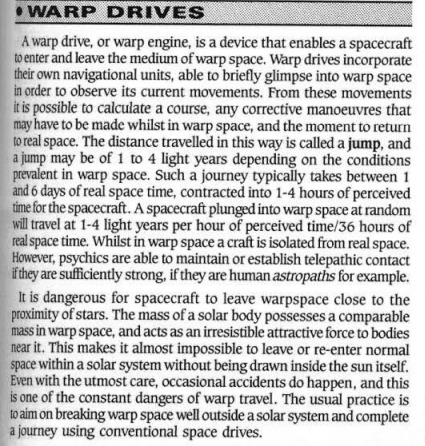
the section on warp drives and how they work, im not sure how accurate or effecctive 1-4 light years per jump is but it is the most detailed explanation ive seen as to how it actually works [as opposed to warp travel being random as fuck]. i also rather like the explanation as to why you can’t exit out of warp space right next to suns [and likely planets as well though thats conjuncture on my part] as youll just fuck up your ship if you do. On a side note, it says navigational drive instead of machine spirit/servitor or the like here cause 1st edition 40k imperium utilized robots instead [im guessing the men of iron and their rebellion wasn’t a thing yet].
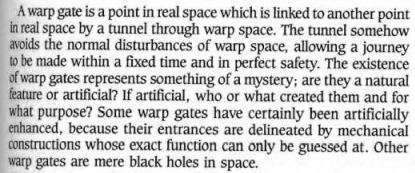


Warp gates were also a thing and seemed to be implied as a common method of warp travel, and likely the main method of going long distance in a practical length of time.

they were aliens alll alonnnng! kidding aside, i like the idea that the dangers of the warp was more so psychic predatory alien species just chillin there rather then it just being a one to one copy of fantasy battles chaos gods. gives the setting a more unique flavour ya know.

some early info on warp storms with a 10% stastic of all solar systems cut off by warp storms to highlight the frequency of them.
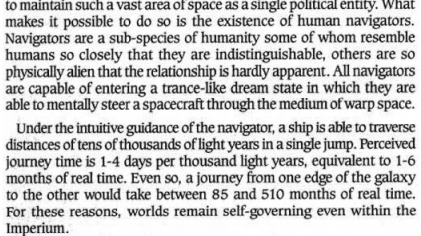
early navigator info, seems their appearance was a lot less strictly defined and the third eye doesnt seem to be a thing yet. some info that explains why their so useful as well to keeping the imperium together despite it being “so thinly spread” compared to other space empires.

early figures on the astronomicans range. it not covering the eastern fringe at all i find fairly interesting cause ultramar in modern 40k is positioned firmly in the eastern fringe of the galaxy.
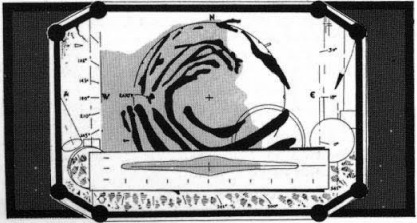
for reference, heres what i assume is a map showing the effective range of the astronomican

nothing particularly notable outside of the weird implication that the emperor was far less of a vegtable here then he is now.

seems the imperium was far less monotheistic then as it is in modern 40k. Makes me wonder what other gods an imperial pantheon might have.
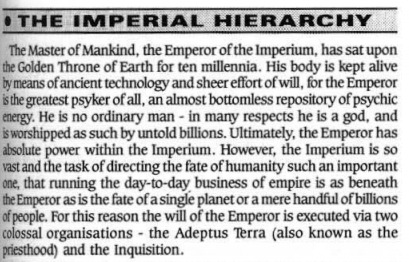

1st edition emperor was far less of a punk then modern emperor it seems, since it doesnt look like he needed 1000 psykers a day just to keep him goin. 1st edition emperor kept himself alive through sheer force of will. Also the ecchlisiarch didn’t exist back then and instead seemed to function in place of what the high lords do now. Though arguably a lot more effectively since they also seem to cover the ecchlisiarchs duties as well.

the direct subdivisions of the adeptus terra, which in this context gives a much more religious connotations to their jobs. Early custodes were just warrior priests i guess? and the arbites were priest judges? maintaining the astronomica also seems to have originally been a more voluntary effort then the other 1000 psykers sacrificed a day to keep the thing running it is in modern 40k.

the administratum also falls under the direct control of the adeptus terra.

the inquisition is basically the same then as it is now though it seems master of the inquisiton used to be a much more desirable job then it is now.

imperial governers were also basically the same despite in 1st edition being appointed by a religious priesthood administratum.
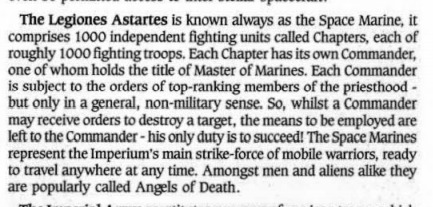
the adeptus astartes originally called legiones astartes cause space rome. Note the effective origin of the continuing space marine problem of scale of numbers cause this effectively means that in 1st edition 40k there are only one million marines in total spread out across the entire imperium. Though the imperium is also implied to be smaller then it is in modern 40k that still seems... insufficient for fighting across an entire galaxy. Also chapter masters were commanders back in the day and like governors not strictly speaking religious just taking orders from the priesthood.



even back then these guys got no respect. Though from the sounds of it the imperial army was closer to the pdf back then well the imperial fleet and space marines were more so responsible for the conquering.

we need more rogue traders with space marine squads under their command in modern 40k, cause that sounds a lot more interesting then deathwatch.

the officio assassinorum was a lot smaller back in the day that they didnt even deserve a proper mention it seems.
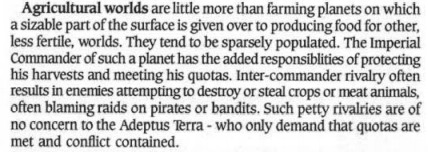
some classic imperial infighting here, with people willing to kill each other over grain quotas. Which sounds like a hell of a basis to make a scenario around let me tell you


civilized worlds, aka hive worlds light/modern earth transplantations are the most common planet type here. I do like the note however of imperial citizens being the usual imperial citizens.

feral worlds are basically the same though i find the early setting pieces on the legion astartes and the imperial commanders fascinating for all the implications it provides.

some hive world stuff, most notable is the implication of routine purges to maintain manageable population levels. Which is something you dont surprisingly see very often in modern 40k [usually its just rebellions that have to be put down that call for ‘purges’] and also implies that despite the misery of living in overcrowded hive cities people are still banging like crazy.

as i said, robots were much more of a thing for the imperium then as opposed to now.

apparently grabbing medieval peasants, stuffing them in space suits and telling them to go murder jibbering orks with hand cannons was considered a worse idea then grabbing a caveman to do the same thing? Guess you could consider a medieval world a developmental stage before reaching civilized status.


paradise worlds were space marines do tai chi and yoga i guess and research stations, aka what can we exploit out of this planet.
cappin it there for now, let me know if ya wanna see some more stuff from this fascinating book.
14 notes
·
View notes
Text
HOW JEDI LEIA FAILS ON EVERY CONCEIVABLE LEVEL AND OMITTING BEN FROM THE FINAL SCENE NOT ONLY HAD THE OPPOSITE EFFECT JJERRIO WERE GOING FOR BUT THE ENTIRE CONCEPT OF TRYING TO MAKE THE FINAL SCENE ABOUT LEIA’S “ASCENSION” TO THE JEDI PANTHEON WAS NEVER GOING TO WORK ANYWAY.
First of all; Leia reaches out to Ben as if he's at his worst and she's pulling him back from the brink when it's actually Rey who's going nuts and Ben just defending himself, never taking a single offensive swing at her, even already lowering his blade before she acts. This results in him getting stabbed, confusing the audience as to whether that was her intent or not. Leia then dies and it's unclear even how or why. This could've been explained, using pre-established rules set-up in TLJ, as Leia using the fatal Force projection technique to bring Ben a vision of Han, or introducing the ability of Force Sensitives to recall non-Force Sensitive spirits from the afterlife, which would've been perfectly believable as a fatal technique, even if it wasn't set-up beforehand. But instead, Terrio the Terrible claims Han was entirely a figment of Ben's imagination and Leia had nothing to do with it. So what should’ve been Leia’s greatest moment of heroism ends up being confusing, achieving way less than anyone thought, and kinda making her look bad, actually.
Second; Leia gives up her Jedi training because she had a vision that her son would die at the end of her path. Then Luke gives Rey Leia's saber and tells her she'd want her to finish her journey. None of that makes any goddamned sense.
What is a Jedi's path? Is it the trial they take to graduate from Padawan to full Jedi, or Jedi to Master Jedi? Is it a life mission, or just whatever current mission they're on? I mean, arguably Leia's whole life was dedicated to destroying the Empire, so even if she never met Palps or knew anything about how he'd personally victimized her family you could say defeating him was finishing what she started. But Leia was fighting the Empire long before she started her training, before she ever knew she had the Force, and she didn’t stop fighting after she quit training. She didn’t need to be a Jedi or a Skywalker to fight Palpatine and the Empire anymore than any other non-Force Sensitive in the Republic/Resistance. Her life would’ve been pretty much the same if she never found out about her lineage or abilities. The concept of a "Jedi path" is just words in a sequence that means nothing to the audience, so how was anybody supposed to get that Rey using her saber to defeat Palpatine would complete it so she could “ascend”?
Not to mention that the very idea that you can complete someone else's journey that way goes against any natural train of logic that anybody would have. Like, it'd be one thing if Leia died like the characters in R1, who give their lives so others can complete another leg of the journey, or to pass along something crucial to achieving victory. But she doesn’t save Rey when she dies, because she’s not in danger, and she certainly didn’t need to die to pass along her saber to Rey, even if you want to argue that her saber was crucial to Palpatine’s defeat.
Leia's death had no correlation to Rey's victory and that's not even how Terrio explains it. He frames it like using Leia's saber fulfilled her Jedi path, rather than Leia’s Jedi path being fulfilled by her making a sacrifice that allowed Rey to finish what she started by defeating Palpatine. This, coupled with the “burying symbolic infants” thing indicates that JJerrio are trying to deify lightsabers as if they’re extensions of a Jedi’s spirit, rather than tools, despite canon indicating otherwise. Anakin broke at least two sabers before he got the one that was passed on to Luke and he and Obi-Wan wielded random spares in the climax of AotC. Luke loses the legacy saber and just builds a new one, then tosses it aside when he commits to not killing in anger. Lightsabers are cool and sentimental because they’re handmade and personalized, but at the end of the day, they’re still just tools that can get lost or broken or even thrown away and it’s not that big a deal. It’s not even like in Harry Potter where you only get one wand that bonds to you and you’ll never be able to perform your best magic with any other so you’d better not break it.
Third; After Ben dies, Leia's body disappears and Maz smiles and nobody understands why. It sounds like Terrio's intent was that Leia could only "ascend to the Jedi pantheon" when her path was complete, (which goes against the canon explanation about who gets to become a ghost and how) and the conditions for completing her path were apparently 1) Palpatine had to be defeated by someone using her lightsaber and 2) her son had to die. But because the Jedi path thing made no sense and directly contradicts canon on multiple points, nobody gets it. So everyone grasps at straws trying to come up with reasonable explanations like, "She was waiting to meet her son" or "She was supposed to use the last of her life force to save Ben and subvert the prophecy before the ending was changed.”
Fourth; Ben's body disappearing ends up muddying the waters further because we don't know what the conditions are for someone to become a ghost either at the moment of their death or after a delayed period of time. Why do Luke, Obi-Wan, Yoda, and Ben's bodies disappear instantly but Leia, Anakin, Qui-Gon, and all the other Jedi killed during Order 66 don't? It's only ever briefly mentioned to be a technique that you have to learn at the end of ROTS so in most people's minds becoming a ghost, whether it's instantly or not, is kinda considered the default for Jedi and not just reserved for the elite few.
Because of this, Ben disappearing reads as significant to the audience because it means he died a hero like Anakin and went to space heaven. But you expect that of Leia, because she was always a good guy, and had Jedi training, so even if you remembered that tidbit from ROTS about it being a skill you have to learn, there’s no reason to think she wouldn’t have learned it when she trained with Luke. Nobody thinks of it as "Oh, I'm so proud of Leia! What a big moment for her! She did it! She learned the super secret technique and now she’s in the Cool Kids Club" because it doesn’t click for anybody that there should’ve ever been any doubt that she could.
Fifth; Finally, we get to the end of the movie and JJerrio decided to only feature Luke and Leia as ghosts, reasoning that Ben or Anakin or anyone else's presence would distract from Leia's moment. But as outlined in the previous points, the entire premise behind that never would've worked in the first place. The fanservice was already had just from seeing Leia wielding a lightsaber and being told she had trained with Luke and knew all the badass stuff he knew and therefore was an equal to him because god forbid anyone in SW have value if they don't have a laser sword. Leia appearing as a ghost was something we already expected even before that retcon, ever since we first learned she was Luke's sister.
Her merely appearing as a ghost doesn't get across to anyone that "NOW she's a REAL Jedi and not just a mere Force Sensitive who went through all the Jedi training and learned all the cool tricks but never got her diploma from Jedi school so it didn't count before.”
By contrast, if Luke and Leia were surrounded by other Jedi, that would've made it much clearer that the moment was about how she was a fully initiated member of the Cool Kids Club. But because it's just the two of them, the audience reads it as a family thing that excludes half the family, who were both Jedi anyway, so they should've been there regardless of whether you actually wanted it to be read as a Jedi thing or a family thing.
So in JJerrio's alleged efforts to prevent Anakin and Ben from stealing Leia's thunder, their glaring omission ended up overshadowing everything about her "big moment" when no one was even going to think it was a big deal that she was a ghost in the first place even if they hadn’t fucked up the execution so hard.
Meanwhile, if they HAD included Ben, audiences might've just felt the slightest twinge of comfort and closure seeing that at least he and his mother were reunited in death. And for as nonsensically as it was executed, people at least still understood that Leia’s death was supposed to have saved Ben somehow, so having him there would’ve been a much greater statement about her heroism than simply showing up as a ghost because someone else used your sword. It’s like if you signed up to sponsor a needy child in Africa and instead of putting up pictures of the kid with new clothes and textbooks that your money helped pay for on the fridge, you put up a printout of your bank statement with the line showing your monthly withdrawl circled. Like, it’s not the cost to yourself that makes you a hero, it’s the good your sacrifice accomplished.
But what would've made an actual memorable and satisfying end to both Leia's story and the saga as a whole would've been if she'd done as the conspiracy theorists suggested and held out on exiting the mortal plane in order to transfer her life force to her son. Then she would've done at least one actually heroic thing, instead of something that just made no sense and kinda looked like the opposite of what it was intended to be and then whatever it was supposed to have accomplished was undone an hour later anyway but that's fine because she's gonna get credit for something someone else did because they used something of hers to do it.
#reylo#leia#ben solo#kylo ren#princess leia#leia organa#star wars#star wars tros#tros#the rise of skywalker#rise of skywalker#star wars the rise of skywalker
23 notes
·
View notes
Text
EV Battery Technologies
PUBLIC PROFILE
INFO:
Status: Active
Industry: Battery Technologies
Symbol: CSE:ACDC
EV Battery Technologies is a leading Blockchain and Battery technology company with revolutionary, patented Battery Management Systems (BMS)
Market OverviewThe Supply Cannot Meet the Demand for Batteries Powering EVs and Renewable Energy…But This Game-Changing Company May Be as Well-Positioned as Any
A Deloitte report states that total EV sales are expected to grow from approximately 2.5 million in 2020 to around 11.2 million in 2025, then reach about 31.1 million by 2030. Another projection from BNEF expects passenger EV sales to rise to 56 million vehicles by 2040.
But without a sufficient supply of minerals such as lithium and quality technology to produce enough high-quality, long-lasting, and eco-friendly batteries, the potentially $3 trillion EV market could all but grind to a halt.
The Top Reasons to Consider Extreme Vehicle Battery Technologies (CNSX: ACDC)
1. A Deloitte report states that total EV sales are expected to grow from approximately 2.5 million in 2020 to around 11.2 million in 2025, then reach about 31.1 million by 2030. Another projection from BNEF expects EV sales to grow to 56 million vehicles by 2040.
2. Without a sufficient supply of minerals such as lithium and quality technology to produce enough high-quality, long-lasting, and eco-friendly batteries, the potentially $3 trillion EV market could all but grind to a halt.
3. Energy Storage Capacity in the US is expected to grow 12x by 2024 to a market value of $5.3 billion. In developed countries, by 2024, the market could grow 40x.
4. The Battery Management System Market could potentially be worth $12.6 Billion by 2024.
5. Extreme Vehicle Battery Technologies is well-positioned to meet this growing demand through an AI-based patented battery management system, real-time monitoring, eco-friendly ecosystem, and cutting edge storage system.
6. A strategic partnership with an industry leader sets Extreme Vehicle Battery Technologies up for a potentially robust 2021 and beyond.
With all of the tailwinds indicating robust growth potential for the EV market, interest appears to have increased for companies such as Extreme Vehicle Battery Technologies (CNSX: ACDC).
As Tesla is set to officially join arguably the most prestigious large-cap stock index in the world (S&P 500) after markets close on December 18th, this is only one sign of the surging demand for electric vehicles. While Tesla is now the most valuable automaker in the world and will be the 7th largest company on the S&P 500 from day 1, more and more EV companies are going public, while established automakers adopt EV models. With governments promoting the adoption of EVs, as state pension funds and national pension funds divest from oil and fossil fuels, it is no wonder that EV sales are forecasted to balloon.
However, without a sufficient supply of minerals such as lithium and quality technology to produce enough high-quality, long-lasting, and eco-friendly batteries, the potentially $3 trillion EV market could all but grind to a halt.
According to research from BloombergNEF, lithium demand could increase by approximately 9x. Additionally, Energy Storage Capacity in the US is expected to grow 12x by 2024 to a market value of $5.3 billion while the market could grow 40x over the same period in developed countries. Specifically, the Battery Management System Market could potentially be worth $12.6 Billion by 2024.
The problem in 2020 though, is that the current tech for lithium-ion batteries is not sufficient enough to keep up with demand.
Why is this tech not sufficient enough to keep up with the demand? Batteries, first and foremost, require expensive lab-based testing to effectively diagnose issues. Furthermore, because testing is so long, expensive, and inefficient, overpriced/costly replacements are unfortunately the normal solution. Additionally, because used batteries are terrible for the environment, what is the point of moving on from “dirtier energy” if the supposed “cleaner energy” EVs are no better for climate change? Lastly, EV battery warranties cover 8 years and can cost companies millions.
Because of this, the market has shifted its focus to better and longer-lasting batteries. Additionally, batteries that are more technologically advanced, eco-friendly, and efficient, are desired by EV automakers and consumers alike.
This is where Extreme Vehicle Battery Technologies comes into play.
How Can Extreme Vehicle Battery Technologies Solve These Problems?
Major technological advancements are required to meet the ever-growing and evolving demands for EV batteries. Through an AI-based patented battery management system, real-time monitoring, an eco-friendly ecosystem, and cutting edge storage system, Extreme Vehicle Battery Technologies is well-positioned to meet these growing needs and demands. All with the end goals of accomplishing the following:
More efficient batteries
A recycling system for batteries
Larger storage of energy
Longer battery life
Better monitoring systems
Faster and more efficient charging
Better maintenance systems
Revolutionary AI-based Patented Battery Management System
What sets up Extreme Vehicle Battery Technologies for success is the fact that it is using artificial intelligence to create a one-of-a-kind, proprietary, and patented battery management system (BMS). Through AI, the company is applying over 5-years of data from hundreds of thousands of EVs in the world’s largest markets. With this AI, the company has created a BMS that “learns” and improves in real-time and one that is fully scalable to any BMS application.
This system first and foremost aids batteries in having a longer life span through real-time power routing options to avoid and minimize damage. The system also excludes and isolates individual damaged cells, and re-routes to exclude the bad cells with a notice for routine maintenance to repair or replace.
Additionally, the system promotes more efficient battery usage through absolute differentiation of individual cell issues in real-time, constant power optimization and flow control, and life extension, charge extension, and massive cost savings.
Extreme Vehicle Battery Technologies’ battery system also has a patented more accurate and reliable method of predicting failure, real-time monitoring, observance, and maintained oversight of batteries, and industry-first remote maintenance protected by multiple patents.
The Company’s Real-Time Monitoring Could be Game-Changing
One of the biggest benefits of Extreme Vehicle’s cutting-edge BMS is its real-time monitoring capabilities.
The company’s system allows real-time monitoring on top of an advanced review of individual cell degradation. The system then applies AI to the data collected to improve technology. With this real-time monitoring, it also allows for less downtime, more efficiency, instant notification of issues, remote repair of hardware and software, and better usage of both maintenance and human expenses.
To sum it all up? Even greater intelligence can be built over time while giving batteries increased longevity- one of the biggest pain points of today’s battery market.
Ev Battery Technologies isn’t Just Talking About Being Eco-Friendly- They Practice What They Preach
Extreme Vehicle Battery Tech uses exclusively used and recycled batteries in all of their solutions. This is especially crucial for the growth of the EV market. EV consumers want to help reduce carbon emissions and combat climate change- this is indisputable. But for that to truly be accomplished, it is very important to effectively use and recycle used batteries. Used batteries are terrible for the environment- so then what is the point of moving on from “dirtier energy” if the supposed “cleaner energy” EVs are no better for climate change?
The e-waste situation is only getting worse too- despite the general public becoming more environmentally conscious. The amount of e-waste generated is expected to exceed 50 million tons by 2020, with annual growth between 4% and 5%. But if you think this is bad now, wait until 2050 when it’s expected to more than double to around 111 million tons. To show how truly dire this is, in 120 countries, annual e-waste EXCEEDS their annual GDPs, while only 20% of e-waste is recycled worldwide.
Through its eco-friendly usage of used batteries, Extreme Vehicle Battery Tech comes is solving yet another crucial problem.
Smart Energy Storage Systems and Metadata, and Charging Stations Also Give Extreme Vehicle Battery Technologies an Edge
With its smart energy storage systems, the company is perfectly positioned to aid in renewable energy, buildings, back up systems, and remote industrial operations. However, what might be arguably even more exciting is its metadata capabilities.
Metadata is a multi-billion dollar market, and could quietly become the most valuable aspect of the business. With each client, with each battery, and with each solution, Extreme Vehicle Battery Technologies gathers metadata in real-time. This metadata combined with AI increases the efficiency and performance of its operations, and also assists with future battery design.
Lastly, as the global electric vehicle charging station market size is expected to surpass over $39.2 billion by the end of 2027 and witness a CAGR of 40.7%, Extreme Vehicle Battery’s offering is arguably the perfect solution for the perfect time.
Its Strategic Partnership With Rich Power Also Sets it Up for Success
Extreme Vehicle Battery Technologies recently formed a strategic partnership with Rich Power. Rich Power is a global leader in BMS and ESS technology and innovation. With this partnership, Extreme Vehicle Battery Technologies now has access to full facility automation production and research with an IS9001/TS16949 quality management system. Additionally, between the two companies, there are 70 + patents and software copyrights including 7 authorized invention patents. There are also more than 20 utility model authorizations, and more than 10 software copyrights directly related to BMS and ESS.
Key Takeaways for Investors
Extreme Vehicle Battery Technologies couldn’t be operating at a better time. Although numerous tailwinds are indicating robust growth potential for the EV market, there are significant headwinds regarding the industry’s scalability, and ability to meet supply with demand. This is where Extreme Vehicle Battery Technologies comes into play.
Extreme Vehicle Battery Technologies solves the problem of having enough high-quality, long-lasting batteries. It also solves the problem of making an eco-friendly business as eco-friendly as it possibly can. It also uses unique, proprietary, and cutting edge technology to oversee and operate as impressive and revolutionary a BMS as there is on the market. Most important, this is a company that with a key strategic partnership, can truly scale with the EV market, and eventually become a vital player to not only the growth of the industry but the survival of the industry as well.
https://investorsscene.com/ev-battery-technologies/
1 note
·
View note